


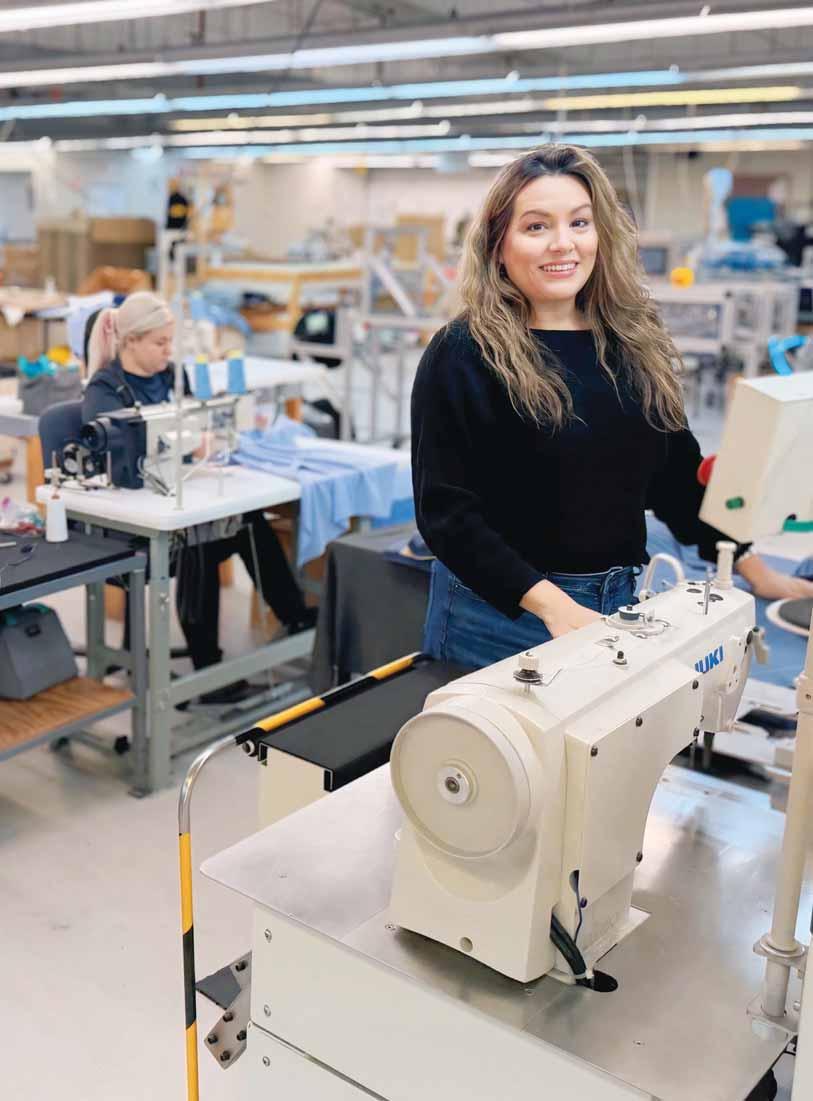




























































































































































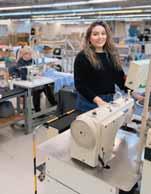
America Knits, Swainsboro, Ga., is a modern cut-and-sew facility with a mission to revive “Made in America,” while working differently to attract a younger workforce.
Co-owner Steve Hawkins and his wife Alejandra, pictured operating the company’s automated pocket setting machine, regularly work in the plant where employees are treated like family.

Carter discusses the company’s part in developing the U.S. hemp ecosystem — growing, processing and building partnerships.
Knits: Sparking Big Change In A Small Town
America Knits is a modern cut-and-sew operation in rural Georgia built with a mission to revive “Made in America.”
with FTC regulations is essential to avoid enforcement actions,

AAs 2025 draws to close and the turmoil of the past year lessens with signs of a new footing taking hold, many view the 2025 blitz on the long-held framework of U.S.international trade policy as a dream come true.
A new fair-trade focus establishing America’s self-interests as a cornerstone of policy broke with the long-held commitment to an open,“free”trade policy,fraught with barriers to U.S. manufacturing competitiveness.
In a split second,an extremely contentious divide opened in the status quo of not only trade policy, but global relationships,alliances and longstanding assumptions concerning the goals of U.S.trade policy.
Even at the time of this writing,with the U.S.Supreme Court yet to rule on President Trump’s authority to enact such a tariff regime,the president’s proponents espouse other avenues the president will, could,or should pursue if the court rules against him.
Investment has been stymied by the tariff effect on imported machinery, a weak U.S.dollar and the benefit of new full depreciation tax policy not really hitting home.
Throw in a government shutdown — which affects numerous government business relationships,health insurance uncertainty and lack of consensuses on the future of the very existence of humanity — and it is a murky stew. Will cooler heads prevail in 2026? One would think so,but there are many challenges ahead.
If President Trump’s history as a negotiator is considered,it is a by-his-book approach to stake an extreme position,
well beyond the goals of the negotiation, and then settle back to a more moderate position.It has happened over and repeatedly,but few take notice and settle quickly. It is painful to watch and well outside the nature of statesman-like behavior but,in many cases,can be extremely effective.
In 2016,similar concerns for the future took hold after his election — before he was even sworn into office.Back then,the economy really sprang to life as business and consumers felt reassured that the world wasn’t going to end.Political battles raged in President Trump’s first term within his own party and in opposition.The internal hostility seems to have moderated this time,with steep political and social hostility very much in place.
U.S.textiles has always survived,and even thrived,by doing a good job of “reading the room.”The National Council of Textile Organization (NCTO) has had an effective run at getting the voice of the industry heard in Washington.Though not spoken of everyday,the end of the de minimis loophole for low-value commercial shipments is a major achievement and step forward towards fairer trade.
What will happen with the USMCA agreement that links the United States, Canada and Mexico into a trading block; or the CAFTA partners — some of which are not admired by the president; or even the Berry Amendment? Who knows?
That said,may 2026 be a healthy and prosperous new year!
James M. Borneman jborneman@TextileWorld.com
EDITOR IN CHIEF James M. Borneman
EXECUTIVE EDITOR Rachael S. Davis
TECHNICAL EDITORS Dr. Lisa Parillo Chapman
Dr. Peter J. Hauser
Dr. Trevor J. Little
Dr. William Oxenham
Dr. Behnam Pourdeyhimi
Dr. Abdel-Fattah Seyam
Dr. Andre West
CONTRIBUTING EDITORS Jim Kaufmann
INTERNET CONTENT EDITOR Rachael S. Davis
CIRCULATION MANAGER Julie K. Brown-Davis
ADVERTISING BUSINESS MANAGER Denise Buchalter
ART & PRODUCTION MANAGER Julie K. Brown-Davis
OWNER/PUBLISHER James M. Borneman

PO Box 683155, Marietta, Georgia 30068, USA Telephone +678-483-6102
www. T e x t i l e W o r l d .com
ADVERTISING REPRESENTATIVES
UNITED STATES/CANADA Turner Marketing & Media, LLC +864-594-0921 • sturner@textileworld.com
MEXICO, CENTRAL & SOUTH AMERICA Virgilio L. González + 58-412-622-2648 • vlgonzalezp@gmail.com
EUROPE (except ITALY) Sabine Dussey +49-171-5473990 • sabine.dussey@dussey.de
ITALY Ferruccio & Filippo Silvera +39-022-846716 • info@silvera.it
ASIA James M. Borneman +678-483-6102 • jborneman@textileworld.com
INTERNET & CLASSIFIEDS OPPORTUNITIES Julie Davis +678-522-0404 • jdavis@textileworld.com





Spartanburg,S.C.-based Milliken & Company has acquired the assets of Highland Industries Inc. in Cheraw,S.C.,in a move that bolsters Milliken’s technical textiles capabilities and strengthens its U.S.operations.Milliken said the Highland site will serve as a regional hub for technical textile weaving and knitting.
“We remain committed to the U.S.textile industry and grounded in our belief that precision manufacturing of innovative,high-performance materials is crucial for industrial resilience,”said Halsey Cook,president and CEO of Milliken.
“In addition to reinforcing current operations, acquiring Highland adds new offerings to the technicaltextiles portfolio,”said Allen Jacoby,executive vice president,and president of Milliken’s technical textiles business.“Highland provides important assets to help us better serve our customers and opens the door to new growth opportunities.”
In other Milliken news, the company was recognized with a 2025 EcoVadis Gold Rating for the fourth consecutive year.The award puts Milliken in the top 5 percent of the more than 150,000 global organizations that are considered for the recognition each year.
“This recognition reflects the dedication of
our teams around the world and our continued focus on fostering transparency and driving innovation across our businesses,”Cook noted.
Champion Thread Co. (CTC),Gastonia,N.C.,has established the Poovey Family Scholarship in honor of its late founder,Robert “Bob”Lee Poovey III.The need-based undergraduate scholarship will support students pursuing degrees at the Wilson College of Textiles at NC State,Raleigh, N.C.The Poovey family has multiple NC State alumni across three generations, and the scholarship is funded through a permanent endowment created during the Wilson College’s 125th anniversary year.
CTC CEO Matt Poovey said: “This scholarship is more than a recognition — it’s a reflection of my father’s lifelong devotion to the textile industry and his unwavering pride in the Wolfpack.He believed deeply in the transformative power of education, excellence,and service. His passion for textiles was matched by a quiet generosity — he had a gift for recognizing when someone just needed a helping hand and he offered it freely,without fanfare.… This scholarship carries that spirit forward, empowering future students to pursue their goals with
Pakistan-based Artistic Milliners has acquired a majority stake in Cone Denim from Elevate Textiles,Greensboro,N.C. The resulting multinational company will operate under the Cone Denim name,and Artistic Milliners’ Pakistan operations will continue independently. The transaction is expected to close in early 2026.The combined entity will include Cone Denim’s mills in Mexico and China, as well as Artistic Milliners’ garment facility in Parras, Mexico,and its Star Fades International laundry and development center in Los
courage,diligence,and the values that shaped his life and legacy.”
Bob Poovey worked in textiles for more than 50 years and founded CTC in 1979.
Italy-based Itema recently began construction on a new manufacturing site in Ponte Nossa,Italy. The company acquired the unused site in 2022 that previously housed Cotonificio Cantoni,and is moving forward with a multi-step redevelopment plan intended to modernize operations and expand its presence in the Seriana Valley.Step one,now underway and scheduled for completion in 2027, includes a world-class production hub to support
Angeles.Cone will operate as a standalone portfolio company led by President Steve Maggard.
“We are committed to bringing the full breadth of our expertise to help unlock Cone’s competitive strengths,”said Artistic Milliners’Murtaza Ahmed and Omer Ahmed in a joint statement.“Cone Denim will preserve its unique identity while continuing to drive its own business strategy.Our goal is to collaborate closely with the Cone Denim team,building on the legacy and achievements of more than 130 years.”
Itema’s weaving machinery production.The project later will include development plans for Lamiflex S.p.A.
“In 2022 we took the decision to begin a journey that would lead Itema Group to have a position adapted to the turbulent changes taking place and at the same time strengthen our brand,which is recognized throughout the textile world as an ambassador of‘Made in Italy’,”said Ugo Ghilardi, Itema Group CEO.“One step of this journey involves both process and production,and product assets,which find a home in this new manufacturing site in Ponte Nossa.”
Mayer & Cie.,a Germany-based manufacturer

of circular knitting and braiding machines,has filed for insolvency under self-administration.The company,which employs about 280 people,cited a significant decline in global demand.Wage and salary payments are secured for three months through insolvency benefits.
Mayer & Cie.reported that geopolitical tensions, including the U.S.-China trade conflict and the war in Ukraine,have discouraged investment,while high inflation in Turkey and price pressure from subsi-
percent drop in sales last year.
In the self-administration process,management will oversee restructuring with support from specialist Attorney Martin Mucha of Grub Brugger,who joins as general representative.
“On Thursday,together with the management,I informed the workforce about the insolvency application,”Mucha said.“At the same time,the necessary steps were taken to maintain business operations. We intend to continue business operations as
on maintaining the company’s core competencies.”
Germany-based KARL MAYER will discontinue its flat knitting machine business under the STOLL brand as part of a strategic shift toward warp knitting, warp preparation and technical textiles.Manufacturing at the STOLL production site in Reutlingen,Germany,has already ceased, and production in China will cease by the end of the
“STOLL stands for a long tradition,”said Oliver Mathews,president of the STOLL Business Unit.
“That is precisely why we deeply regret that we were unable to lead the business into the future successfully. It was not possible to find an investor to continue production at the main site in Reutlingen with its 280 employees.”
KARL MAYER will continue servicing the installed base,with spare parts to be supplied from warehouses in Obertshausen,Germany, and China.Software license keys will remain available. TW
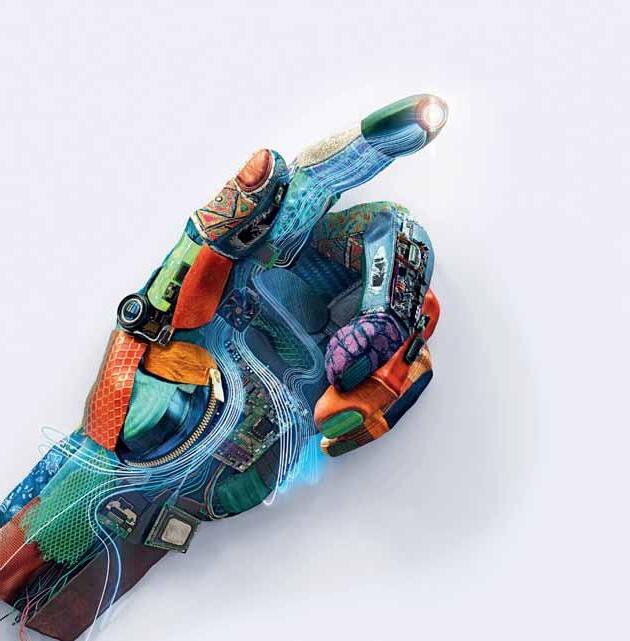


APR 21–24, 2026 FRANKFURT, GERMANY



trend agency with more than five decades of experience. According to organizers, the showcase will introduce “the season’s key color stories, material innovations and creative directions — translating future trends into tangible inspiration for designers and sourcing professionals alike.”
Offers New Features, Unified Innovation Hub
Offers New Features, Unified Innovation Hub
Texworld NYC taps Peclers Paris for trend direction while introducing fresh programming, and a reimagined Innovation Hub for sourcing professionals and designers.
TW Special Report
JJanuary 20-22, 2026, the textile and garment industry will gather in New York City at the Javits Center for Texworld NYC. The biennial trade event will collocate with Apparel Sourcing NYC and Printsource for the Winter 2026 Edition to create a hub for fabric sourcing and solutions for the textile and garment industry.
Texworld, organized by Atlantabased Messe Frankfurt Inc., is a showcase of fabrics in on trend-color palettes comprising basics up to those containing unique fiber blends and innovative structures.
Apparel Sourcing NYC is a joint venture between Messe Frankfurt and China-based Sub-Council of Textile Industry, China Council for the Promotion of International Trade (CCPIT-Tex). Exhibitors specialize in finished apparel, contract manufacturing and private label development. Apparel and accessories will be displayed including ready-to-wear collections for men, women and children.
Printsource highlights hundreds of design collections from surface designers and textile design studios all over the world. Applications include apparel, bed and bath, kitchen and tabletop, wall coverings and window fashions, among other applications.
Organizers are combining the Next-Gen Materials, Technology Lab and Solutions Studio into a single destination — the Innovation Hub. Within the hub, visitors can learn about biobased, circular and low impact textiles, digital tools and artificial intelligence systems including blockchain and 3D design, as well as services offering transparency and accountability options for the global supply chain.
As always, trend forecasts form the heart of Texworld NYC. This edition’s Texworld Trend Showcase is curated by trend partner Peclers Paris, a creative consultancy and
“We believe every story in fashion begins with the fabric,” noted Yvonne de Bruyn, Trend & Type director for Consultancies, Peclers Paris. “It is the foundation of creativity, the vessel of emotion, and the touchpoint of connection. Fabric shapes not only garments, but also the narratives they carry and the feelings they evoke. That is why we are proud to partner with Texworld New York, bringing our trend-driven vision to the fashion capital of the United States.”
The Chicago Pattern Maker Founder and President Xochil Herrera Scheer will host a new hands-on tech pack workshop for attendees. “Your Fashion Design Blueprint” aims to demystify the tech pack, which is an essential blueprint for bringing garments to life. Seats are limited and tickets can be purchased during online registration.
Other returning event features include the Exhibitor Pitch stage presented by Texpertise, which will present new products and innovations; Textile Talks where experts will discuss a variety of issues pertinent to the fashion and textile industries; and the Deadstock Sourcing area that will provide buyers access to surplus materials as sustainable sourcing alternatives.
The shows are open 10 a.m. to 5 p.m. on Tuesday and Wednesday, January 20-21; and from 10 a.m. to 4 p.m. on Thursday, January 22. TW
For more information about the shows and to register, visit texworld-usa. us.messefrankfurt.com and printsource newyork.com.
RISE® 2025 —which honored Keel Labs with the RISE Innovation Award (far right) for its Kelsun® seaweed-based fiber —allowed for networking and learning while spotlighting the technologies that are redefining what’s possible in engineered fabrics.




TThe Cary, N.C.-based Association of the Nonwoven & Fabrics Industry (INDA) recently hosted its 15th RISE ® conference, cohosted by The Nonwovens Institute (NWI). The two-day RISE — Research, Innovation & Science for Engineered Fabrics — event focused on emerging technologies and ideas with the aim of connecting innovations with real-world applications for professionals in the nonwoven/engineered fabrics industry. The event this year was held at the McKimmon Center on the NC State campus in Raleigh, N.C.
Topics focused on sustainability and innovation. Carbon-smart materials and fiber science featured heavily on the agenda, and green chemistry and nonwoven processing technologies also were included in the presentations. INDA’s Director of Government Relations, Wes Fisher, concluded the conference with his presentation on “Nonwovens in a Shifting Landscape: Navigating Tariff and Policy Risks in a Second Trump Administration.”
Each year, INDA searches for commercializable technical products and technologies to honor with the RISE Innovation Award. The top three nominees for the award in 2025 — EsterCycle LLC, Rockline Industries and Keel Labs — presented their technologies at the end of the
15th annual RISE designed to explore collaboration and creativity for a more sustainable future in the nonwovens and engineered fabrics industry.
first day of conference proceedings, and then RISE attendees voted for their favorite innovation. Once those results were tallied with votes cast by INDA’s Technical Advisory Board and the affiliated Conference Committee, Keel Labs, Morrisville, N.C., was announced as the winner of the 2025 RISE Innovation Award for its Kelsun ® fiber. The seaweed-based fiber is a sustainable, biodegradable alternative to petroleum-based fibers. Kelsun also is soft, inherently flame resistant and antimicrobial.
The day before the conference, those interested in golf participated in a charity golf tournament at the Lonny Pool Golf Course on the NC State campus. Money raised by the tournament supports graduate students with travel costs to attend INDA events.
During the conference, attendees had the opportunity to learn about research taking place at a variety of universities via the graduate research
posters that were on display. It’s a great opportunity for the students to share their work with industry experts and potential investors. Tabletop exhibits from participating companies also were positioned around the posters in the exhibit area offering additional learning opportunities.
At the close of the conference, attendees were given the chance to tour NWI. This “Open Innovation” resource on the Centennial Campus of NC State comprises a consortium of stakeholders spanning the breadth of the nonwovens value chain. The collaboration between academia, industry and government works to develop nonwoven solutions and is the first accredited academic program for engineered fabrics. NWI houses more than $65 million in pilot lines and analytical labs for trials and development work.
“RISE continues to spotlight the technologies that are redefining what’s possible in engineered fabrics,” said Dr. Matt O’Sickey, INDA’s director of Education & Technical Affairs. “From renewable carbon and green chemistry to next-generation fibers and recycling innovations, this year’s conference showcased the kind of collaboration and creativity that will shape a more sustainable future for our industry.”
INDA has announced the date for RISE 2026, which will return to the McKimmon Center August 2526, 2026. TW
Meredith Boyd, executive vice president, chief product officer, UNIFI® and SYFA president
Exploring recent developments in fiber innovation, trade and the economy, the Synthetic Yarn and Fabric Association delivered at its recent fall conference.
TW Special Report
TThe Charlotte N.C.-based Synthetic Yarn and Fabric Association (SYFA) recently held its annual fall conference at the Sheraton Charlotte Airport Hotel in Charlotte, N.C.
SYFA President Meredith Boyd opened the conference stating: “Our theme this conference, ‘From Fiber Forward: Technology, Trade, and Transformation,’ captures what this moment means for our industry. Today, we’re no longer just a manufacturing sector, we’re a strategic industry that anchors national security, environmental progress, and economic competitiveness. We are the quiet enablers behind nearly every major innovation shaping modern life, and it all starts with chemistry, engineering, and ingenuity.”
Senior International Trade Manager with the Economic Development Partnership of North Carolina, Jeri Barutis, hosted a discussion with Felicia Pullam, senior director, GeoCommerce, APCO Worldwide, tackling the topic “Trade & Compliance: Challenges & Opportunities in the Textile Industry.” The exchange explored how to navigate trade policy and gave insight into actions small and mid-sized companies may use to deal with compliance issues.
Matt Yakush, Global Market Development leader, Kevlar® EXO™, and Jake Pretko, lead engineer II, R&D
Aramids Product & Process Development, DuPont, presented “Kevlar EXO: Innovating the New Generation of Technical Textiles.” The duo explained the history of Kevlar and the innovations achieved with Kevlar EXO including increased strength, weight savings and flexibility.
Well-known textile trade professional Auggie Tantillo with SRG & Associates presented “A Federal Textile Trade & Tariff Review.” Exploring the chaotic trade landscape, Tantillo gave his take on the good and bad of current trade issues and raised concern regarding the future of the Berry Amendment.
Craig Lindemann, a technical specialist, Product Integration, Reju, presented “Reju: Building a Circular Textile System. He explained Reju as a systems change company that uses selective depolymerization of polyester and a network of feedstock suppliers, brands, and resellers to create a circular textile system.
Roger Tutterow, Henssler Financial Endowed chair, professor of Economics, Kennesaw State University, presented an Economic Review tuned for textile executives. Always entertaining, Tutterow gave context to the current economic situation.
Dr. Ramesh Kesh, senior vice president and Global Business manager - Polartec, and Government & Defense with Milliken & Company, gave an in-depth overview and update on Polartec, titled “Innova-


tion Made to Go Beyond.” Dr. Kesh’s command of the topic of innovation and application was insightful.
Billy McCall, Kintra Fibers’ founder and CEO, discussed “Next Generation Polyester Yarns: Looking Back in Order to Move Forward,” and described his initiative as an interested scientist bringing a fresh approach to fiber challenges while developing a biobased polyester.
Tamsin Ettefagh, chief sustainability officer and vice president of Industry, PureCycle Technologies, presented “Recycled PP for Fiber Applications.” An industry veteran, Ettefagh spoke of her personal journey transforming and reusing postconsumer plastics in meaningful ways.
In concluding the conference, Boyd offered remarks, saying: “Our industry may be centuries old, but it’s also among the most dynamic on earth. We have the rare ability to impact everything, from what people wear and how they work and play, to how they move, heal, and even protect their lives. We’re advancing a shared mission: to make textiles smarter, stronger, and more sustainable for the world we live in.”
SYFA will hold its Spring Conference April 1-2, 2026, at the Sheraton Charlotte Airport Hotel. The SYFA Annual Spring Golf Tournament to raise money for the SYFA Scholarship at Gaston College will be held Tuesday, March 31, 2026, at The Rocky River Golf Club, Concord, N.C. TW
Panda Biotech’s President Dixie Carter discusses the company’s part in developing the U.S. hemp ecosystem — growing, processing and building partnerships with an eye on sustainability.
TW Special Report

IIt was clear early on in this interview that Panda Biotech’s story was about much more than just building a new hemp gin in Wichita Falls.
Panda Biotech’s President Dixie Carter captured the scope of Panda’s approach saying:“By combining regenerative agriculture with clean,efficient technology, we’ve created a model that aligns with the future of sustainable textile manufacturing: local,traceable and circular.The result is not only a lower-impact natural fiber alternative but also a blueprint for how innovation and sustainability can coexist at industrial scale — right here in America.”
And that is the heart of the story,something that’s much bigger than a plant or a company,but is a new industry from farm field through final products.
Carter recently sat down with Textile World to share her take on creating a new industrial hemp ecosystem.
TW : How did the idea of developing a scalable
industrial hemp ecosystem take shape?
Carter: After decades of building clean energy projects,Panda saw industrial hemp as the next frontier in sustainability. The same principles that powered Panda Energy’s success — innovation,efficiency and environmental responsibility — now drive Panda Biotech as we build a fully integrated,zerowaste hemp fiber ecosystem here in America.
TW : How did your previous executive experiences assist you in your role at Panda?
Carter: Throughout my career,I’ve led collaborations with some of the world’s most recognized brands across entertainment,fashion,merchandising and industry.My expertise lies in building brands that connect deeply with people — through storytelling,marketing strategy,global partnerships and capital development.At Panda Biotech, those same principles
apply.We’re building a movement as much as a business — reintroducing American-grown,Americanprocessed hemp fiber to the global textile market.
TW : How does Chairman Bob Carter’s “no excuses”leadership style,influence your management approach?
Carter: Bob’s no excuses leadership sets a tone of accountability and action.He believes every challenge has a solution — and that mindset has become the heartbeat of Panda Biotech’s culture. This mindset reinforces that there’s always a way forward,but it requires discipline,collaboration, and an unwillingness to let obstacles become excuses.
TW : What milestones has Panda Biotech achieved in the development of American Hemp?
Carter: Panda Biotech’s momentum has been built through a series of strategic milestones from purchasing the building,sourcing the
right equipment and building out our facility,raising capital,finding the right seed to grow in our region, partnering with farmers and then working with them to have a successful harvest,commissioning the equipment,working with mills to dial in the right fiber for mass production, and so much more.Panda reinforced each milestone to build credibility,capacity, confidence,and a foundation for a truly American hemp supply chain with global reach and long-term sustainability.
TW : How has Panda’s sustainability focus impacted your choices in designing the Panda hemp gin?
Carter: Sustainability is not a single pillar of Panda’s business — it’s the foundation of everything we do.From the outset, our goal was to demonstrate that industrial hemp can be scaled in a manner that protects both people and the planet.We built the Panda Hemp Gin in


Wichita Falls,Texas,to reflect that commitment in every detail.
Panda’s facility is the most advanced,large-scale industrial hemp processing operation in the Western Hemisphere — engineered for zero waste.Our mechanical cottonization process transforms U.S.grown hemp into a fine, textile-grade fiber,eliminating the use of water or chemicals typically associated with degumming or scouring.Every part of the plant is utilized across multiple value streams.
TW : Building any facility is challenging enough, but what about making
choices — like choosing to pursue mechanical cottonization or using renewable energy?
Carter: From the outset,our goal was to develop a model for large-scale natural fiber processing that could be both environmentally clean and commercially viable — not a pilot project,but a proof of concept for U.S. manufacturing.Our products are OEKO-TEX® STANDARD 100 certified, USDA BioPreferred®,and meet the highest standards for clean fiber production.
Choosing mechanical cottonization was a pivotal decision.We considered bringing degumming in-
house,but the water and chemical requirements ran counter to our sustainability goals.Instead,Panda created a textile-grade fiber using only mechanical cottonization,which had notably fewer short fibers and bundles,and was finer, softer,and longer — similar to degummed and scoured fiber.While this took us longer to achieve, we now have the best and best-priced,mechanically cottonized,textile-grade fiber in the world,at half the price of degummed hemp fiber.This process enables hemp to integrate seamlessly into existing cotton spinning systems, which is crucial for broad textile adoption.
TW : The Wichita Gin is a substantial development. How did you get your arms around the project, and what was the key to managing a team to execute the considerable plan?
Carter: From the outset,we knew that building the Panda Hemp Gin would be unlike any industrial project ever undertaken in this sector — both in scale and
technical complexity.We traveled the world examining equipment and hemp facilities.We assembled an exceptional team of experts in mechanical design, automation,and industrial construction,many with decades of experience in large-scale facilities for the cotton,energy,and agprocessing industries.The state-of-the-art processing line,if measured end-onend,spans 700 yards — or 7 football fields — with three miles of overhead pneumatic ducting,customengineered decortication systems,and a continuous flow design that has never been implemented for hemp at this capacity.
A project of this size demands clarity,collaboration,and commitment. We aligned every engineer and operator around one vision — to build something historic — and that shared purpose made the impossible achievable.
TW : What is your personal connection to Wichita Falls and Seymour,Texas?
Carter: Our family had a ranch in Seymour, Texas,for more than 20 years,so we spent time in the closest big city, Wichita Falls.When we were searching for a building for our first hemp gin,our focus was on very large industrial buildings with high ceilings.When we found a 500,000-square-foot former GM facility on a 97-acre campus that also happened to be in a city where our family had history,we knew we had the perfect place.
TW : Panda’s Gin is just part of the story.Can you address Panda’s concentration on the hemp ecosystem — from the farm to merchantable product — like the “Pay-to-Grow”program?
Carter: The Panda Hemp Gin is the centerpiece of a much larger vision — building a truly scalable and sustainable hemp fiber ecosystem here in the United States.From the outset,we recognized that processing capacity alone wouldn’t be sufficient.To make hemp viable at scale,you need to connect every link in the chain,including regenerative farming,worldclass mills,and finished consumer products.
That’s why we’ve invested heavily in programs that support farmers and mitigate risk for participation.Our Payto-Grow program was a cornerstone of that effort for us at the beginning.It ensured growers were compensated for their work while we provided them with genetically proven and consistent seed,agronomic guidance, and a guaranteed market for their harvested stalks. It was a true partnership model that fostered trust and created economic opportunities for American producers.
Beyond the farm,we’ve built relationships with yarn and textile mills, nonwoven manufacturers, and brands that are eager to integrate our U.S.grown hemp fiber into their supply chains.The result is a fully domestic, traceable,and circular model — from seed to
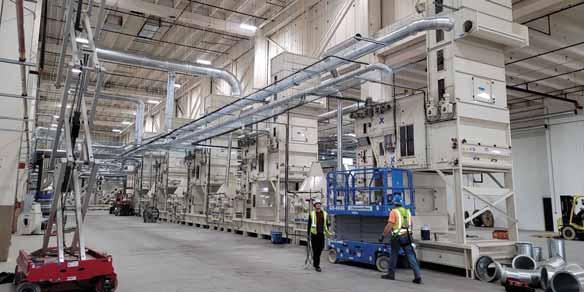
Panda uses only mechanical cottonization, which uses no water and yields fewer short fibers and bundles and at half the price of degummed and scoured hemp fiber.
fiber to finished product — that helps revitalize rural economies while advancing the next generation of sustainable materials.
TW : What is your vision for the future of industrial hemp?
Carter: Hemp is not a fashion trend.It is the future of textiles and fashion.Scientifically proven to absorb more carbon dioxide per acre than any forestry or commercial crop,industrial hemp is the most transformative natural fiber opportunity of our time.It’s renewable,traceable,and circular by design — and it can be grown and processed at scale right here in the United States. Our vision is a global textile industry where hemp stands alongside cotton and synthetic fibers as a core,mainstream fiber — delivering performance, sustainability,and resilience. Early demand is coming from brands and mills that want to decarbonize their supply chains,starting with denim and knits. The long-term potential of hemp touches every sector of textiles.
TW : Are there any significant challenges in developing a vibrant industrial hemp future?
Carter: Any time a new natural fiber enters the global supply chain,the biggest challenge is consistency — mills and brands need to trust that the fiber will perform the same way, every time.Our focus has been on de-risking the transition by producing cottonized hemp fiber that integrates seamlessly into existing spinning systems. We’ve partnered closely with leading mills to conduct extensive spinning trials,optimize blending ratios,and verify quality at scale.By delivering both performance data and a reliable domestic supply chain,we’re helping brands adopt hemp with confidence.
TW : Where does Panda Biotech go from here?
Carter: With the Panda Hemp Gin now fully operational,our focus turns to expanding the ecosystem — deepening partnerships with mills,manufacturers, and brands who are ready to integrate U.S.-grown,
low-impact hemp fiber into their supply chains.
We’re also advancing our bioproducts portfolio,using every part of the plant to create renewable solutions across textiles,nonwovens, and industrial applications. At the same time,we’re working to strengthen our grower network,ensuring that regenerative hemp cultivation continues to create opportunity for U.S.farmers.
In many ways,this is just the beginning.The infrastructure is built,the partnerships are forming, and the demand for sustainable,traceable materials has never been stronger.
The editors of TW appreciate the opportunity to sit down with Panda Biotech’s President Dixie Carter.Her vision is both deep and wide with a bright future for American hemp.As Carter states, “Our mission now is to scale what we’ve proven — to show that sustainability can drive both performance and profitability,and that American innovation can once again lead the world in textile and materials manufacturing.” TW

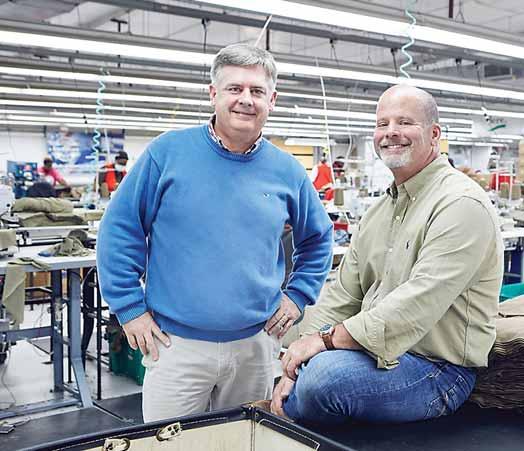
America Knits founders Steve Hawkins (left) and Dr. David Talton

America Knits is a modern cut-and-sew operation in rural Georgia built with a mission to revive “Made in America” and create a new story.
By Rachael S. Davis, Executive Editor
nyone who has spent time in the textile industry knows its greatest strength has always been the people. And it was these warm, welcoming people who made thoracic heart surgeon Dr. David Talton fall in love with the industry after tagging along with his lifelong best friend — apparel industry veteran Steve Hawkins — to a handful of trade shows and conferences.
In 2018, Talton, looking for a new challenge and enamored with the textile industry, and Hawkins, looking for a lifestyle change, decided to partner creating America Knits — a company dedicated to producing premium, high-quality Made in America apparel in Swainsboro, Ga.
Hawkins has been on a remarkable journey in the cut-and-sew business from the time he graduated college with a degree in finance. From Reelsboro and Ayden, N.C., to
Honduras — requiring his first passport at age 35 — and back to the United States in Swainsboro, Ga.
He didn’t expect to work in the apparel industry. “I thought maybe I’d work in a bank,” Hawkins said. But through his part time job, he met Skip Hudson who owned five cutand-sew plants in and around New Bern, N.C., where Hawkins grew up. “Hudson asked me one day what I was going todo after graduation because he knew I was a senior,” Hawkins recalls. “I really didn’t know, and Hudson asked if I’d like to learn about the sewing business. He said his company was taking a different approach and was looking for someone freshout of college to teach the business. They wanted to find someone that could think outside the box.”
This chance offer set Hawkins on a course that would dictate his career to date. After learning about the cutand-sew business at Hudson’s Reelsboro facility, an investor helped
Hawkins open his own cut-and-sew business in Ayden at the young age of 25. The business thrived staying busy from 1988 until 1994, when the North American Free Trade Agreement (NAFTA) came along. “NAFTA marked the first time since I had opened my plant that we saw a slowdown, and it was the first time I’d ever had to lay anybody off” Hawkins said. He had never owned a passport, so when a colleague in the business asked if he’d ever considered going overseas, Hawkins did not immediately entertain the idea. But when he learned if he set up a plant in Honduras that he could keep it running 52 weeks a year, he was intrigued and decided after somemore research, to take the leap. “That’s where I learned a lot of the full package part of the business,” he said. “I also made many connections with Parkdale, as well as other spinners.”
But in a now well-known twist of events, cut-and-sew work slowly began to move to Asia and work was harder to come by in-between seasons for Hawkins’ Honduras facility. He decided to return to the United States and went to work for a larger, global manufacturer in sales and production management. It was a job he enjoyed, and it allowed him to further his knowledge of the business with another layer of learning. But the extensive traveling required to visit customers and offshore facilities meant he was missing out on homelife with his wife and sons. “I wanted a lifestyle change,” Hawkins said. “I had two young boys that were in first and fifth grade and I was missing everything because I was traveling all the time.”
At that point in his life, industry friends were urging Hawkins to consider opening a plant in the United States again. “That’s where David comes in,” Hawkins relayed. “We had been best friends since kindergarten, and we’d always wanted to be in business together. You’d have to
know David, but I guess saving lives wasn’t exciting enough for him,” Hawkins said with a chuckle. “And that’s what brought us to this little town with a population of 7,000 people in Georgia called Swainsboro.”
Attracted by the potential workforce in Swainsboro, the duo first identified a good building for the plant and then invested in state-ofthe-art equipment from the very beginning. They hoped to differentiate America Knits from other plants in the United States. “We knew the facility had to be something different and spent a good bit of money to outfit it and make it like we wanted it to be,” Hawkins said. “We wanted to avoid the old school thinking of ‘let’s get it as cheap as we can and just get started with used equipment.’ My theory was that we need the plant to look different, it needed to be bright, attractive and a place people would want to come to work.”
Displayed prominently on the plant floor is the company’s slogan, “Together, we are building a new story.”
Hawkins really believes in this idea. “The slogan really applies to the employees on the floor — we can only talk about it,” he said. “The story we are building has to be created by everyone involved in America Knits.
“We also hope that when visitors enter our facility that they see the quality of everything we do, not just the quality of the shirts we make,” he said. “If you have a clean, organized facility, I think that environment naturally promotes quality.”
No sooner had Hawkins and Talton got America Knits up-and-running making basic T-shirts, the Covid pandemic hit. “Just like everybody did at that point in time, we pivoted and figured out how to make personal protective equipment [PPE] like masks and isolation gowns,” Hawkins said. “As a cut-and-sew company in
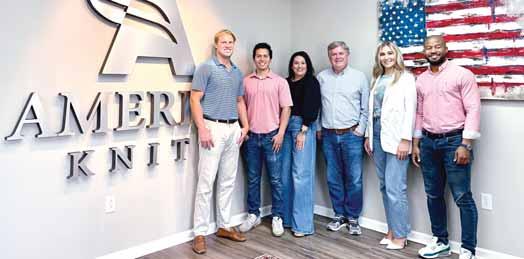

the United States, we were quite fortunate because there weren’t many companies to turn to for help.”
In 2020, Parkdale Inc. led an effort to build a coalition of companies to respond to the nation’s need for PPE, and America Knits was honored to be included in the group. Hawkins said the collaborative effort generated a lot of free publicity for the fledgling company. “We were the smallest company in the group, but for a period of time, every night our name was mentioned on national television!” he said proudly.
That initial exposure attracted the attention of the State of Georgia and Governor Brian Kemp. In 2021, America Knits was invited to the governor’s State of the State speech where the company was highlighted for its efforts to make PPE during the height of the pandemic and the willingness of its employees to step up and work even though there were so many unknowns. That exposure led to more work for the company producing shirts for the Georgia prison
system at a time when inmates couldn’t work in factories within prisons. “It was definitely hard times, but the exposure built us to where we became a recognized company within the state of Georgia and we have received really friendly treatment from everyone involved, as well as numerous state recognitions,” Hawkins said.
As the supply chain shortages created by the pandemic eased, America Knits refocused on its original business plan. The company currently has the capacity to produce a total of 20,000 pieces a week in an assortment of premium T-shirts, polos and sweatshirts — all made using fabric sourced from U.S.-based manufacturers. A recent expansion investment added screen-printing, embroidery and laundry equipment. Hawkins emphasized fit is something that is very important to consumers and that it is therefore important to him that the shirts sold





With its motto “Together, we are building a new story,” America Knits wants its employees to feel like they are part of the company’s journey. The plant was designed to be modern and pleasant to work in, and employees are encouraged to cross train.
by America Knits are true to size and remain so after home laundering. America Knits’ new washing and enzyme equipment allows the company to precisely control the size of the finished garments.
The company aims to add garment dyeing in the not-too-distant future, and possibly even some spinning capability one day.
America Knits also is working closely with a Germany-based automation company that is developing robotic technology for T-shirt assembly. “We are sending them cut parts as they need them so they can tweak and experiment making T-shirts using robots,” Hawkins shared. “When they are ready — and they are getting closer — we hope to get a machine in our plant as a beta site.”
As of today, the company employs 53 local people. In many cases, those associates are quite familiar with the sewing business. “We are trying to
rejuvenate a business where for many of our employees, their mothers, fathers and sometimes grandparents worked in sewing plants when they were young,” Hawkins said. “I think engaging employees is important,” he added. “We need to make sure they know what the goals are, and what the vision is for what we are trying to build. We also want them to feel proud of where they are from.”
“Made in Small Town America” is imprinted in every shirt America Knits makes. “That idea means something to me,” Hawkins said. “There isn’t a large enough workforce for us to grow in Swainsboro, but I would like to replicate the business model in other small towns. I think it’s possible because by automating some of the tasks, we’ve made it a nicer place to work.”
Hawkins credits his wife, Alejandra, with suggesting employees be known as VIPs. They also make a point to celebrate birthdays at the plant. They hope such efforts will attract younger people into the business.
Another change America Knits made to the traditional cut-and-sew business model was to eliminate tying wages to production quantities. It was confusing to employees and sometimes meant losing good people because they didn’t fully understand and connect the hourly wage with the incentivized pay. “We took everyone’s average wage from the prior year and made that their guaranteed salary,” Hawkins said. “We still set goals for the teams but find they are more diligent about reaching the goals now than when they made money for production. We still have set costs, but we know the team costs per hour and in the end, we still get what we need. It was a game changer.
“We also encourage employees that the more they cross-train, the more jobs they can do and the more raises they can earn!”
Hawkins understands the value of training and educating the workforce. He never forgot Hudson’s willingness to give him a chance to learn from the ground up when he was a new college graduate.
“We have a really young middle management team at America Knits that is learning this business, and we take on interns and new graduates to learn as well” he shared. “Our goal is to keep layering on new people — hopefully those that have the ambition to eventually start their own plant someday. I believe in character. I hire the people who may not have the knowledge, but they have the character. For someone with the right character, the sky is the limit!”
When it comes to nearshoring the apparel industry in the United States, Hawkins says the solution is obvious, but not easy to implement. “The problem with scaling and ramping up U.S. manufacturing is the lack of middle management,” Hawkins shared. “This industry is valued in small towns, but once an industry has been gone more than 20 years, middle managers are retired or have
moved on to other work. Unfortunately, the middle management aspects of this business are not learned in one month, six months or even a year in most cases. It takes two to three years to become a good mechanic or maintenance guy or shift supervisor. Without those people, it’s hard to make good product.”
He noted that middle management positions pay more and it’s not feasible as a small business to double up on such positions while people are training. In order to expand, experienced people who can hit the ground running are needed so a new plant can generate revenue while also training new people. Hawkins said the ability to bring in trained people from other countries is one way to open facilities faster and with less risk, but as a major political issue, it’s not a popular idea.
While America Knits did not receive any government funding or assistance when it first opened because of its very small size, the company has since been able to take advantage of some incentive programs. “Georgia has a program where they will pay half of a trainee’s salary for up to 12 weeks,” Hawkins said. “We underwent an expansion and did participate in that program, and it went really well.”
In 2020, America Knits joined the Field to Closet initiative — a program designed to increase demand for cotton fiber, reward growers and support communities — to help with a medical scrub project. The group put together a supply chain in the state of Georgia to make scrubs for rural hospitals that were struggling to get the PPE they needed. The cotton was grown and yarn spun in Georgia, fabric was made in the Carolinas, and the all-cotton scrubs were cut and sewn at America Knits. This collaboration led to a second Field to Closet project with Lumberton, N.C.-based Contempora Fabrics Inc. for clothing brand J.Crew.


The J.Crew collaboration allowed America Knits and Contempora Fabrics to become better acquainted, and the companies have since partnered outside of Field to Closet, with Contempora acquiring a stake in America Knits. “Partnering with Contempora is one of the best things that happened to us since we started the company,” Hawkins said. “We now have the credibility of a partner that has more than 50 years in business, and one that shares a philosophy and has similar culture to our own. In addition, together we form a completely vertical factory, and we are not dependent on anyone.” The companies hope that together, they can build a stronger U.S.-based garment supply chain. A new beanie and cap product line was announced this year as part of this partnership.
When brainstorming on future ideas with Field to Closet executives, Hawkins realized the next step for America Knits was to start its own brand. The discussions led to the Seeds II Seams brand, which was developed with focus on sustainability and is 100-percent American made. The brand logo incorporates a crow because as the crow flies, there is only 238 miles between the links in the complete supply chain for the brand’s garments. In comparison, based on a recent independent study, the average T-shirt sold in the United States trav-
els 17,000 miles from fiber to finished product.
While ruminating on his challenging career in the apparel cut-and-sew industry, Hawkins laughed and said: “I always thought it would be fun to be in sports in some way — maybe as a head football or baseball coach. But maybe this is almost the same in a weird way. You have professional people with God-given talents, and you put them together as teams. Then you have to motivate the teams and have to try to get them to pull together in the same direction to hit your numbers.” It’s an analogy that while unexpected, surprisingly works.
Hawkins also spoke of adrenaline and the extremely competitive nature of the business. “It’s competitive in that you are trying to accomplish goals on a daily and a weekly basis, which causes a lot of stress” he said. “But if you’ve been in this business for a long time, you get addicted to the stress and the excitement and ultimately surviving!”
Hawkins has not only survived but thrived in the cut-and-sew industry adapting, rebuilding and learning at every turn. And with its partner, Contempora Fabrics, and an eager workforce, America Knits is poised for whatever comes next — a future Hawkins approaches with the same curiosity, grit and affection for the industry that has carried him through more than 30 years. TW
Arclin,Alpharetta,Ga.,has entered a definitive agreement to acquire DuPont’s Aramids business, including the Kevlar® and Nomex® brands,for approximately $1.8 billion. The deal expands Arclin’s portfolio into aerospace,electrical infrastructure,electric vehicles,defense and personal protection,complementing its existing positions in construction,infrastructure and transportation.About 1,900 employees will transfer with the business. The transaction is expected to close in Q1 2026,pending approvals.
“We are confident that under Arclin’s leadership,these businesses will continue to thrive and expand their impact in new industries and applications,”said Lori Koch,DuPont CEO.
Austria-based ANDRITZ has partnered with biotechnology company Tandem Repeat Technologies Inc., Philadelphia,to commercialize industrial-scale production solutions for Procell™,a biomanufactured proteinbased fiber designed for textiles and nonwovens.The collaboration combines Tandem Repeat’s fiber development expertise with ANDRITZ’s machinery and plant capabilities to provide manufacturing solutions tailored to Procell’s requirements.Procell offers wool-like softness,strength,and durability,positioning it as an alternative to conventional synthetic fibers.
“By partnering with Andritz,we can bring our revolutionary fiber to market on a commercial scale,”said Tandem Repeat Co-founder Dr.Melik Demirel.
FPM Introduces Wetlaid Nonwovens, Sustainability Report; Expands India Site
Germany-based Freudenberg Performance Materials (FPM) has introduced 100-percent biobased polylactic acid (PLA)/wood pulp wetlaid nonwovens made without using chemical binders.The material combines the water absorption and biodegradability of wood pulp with the strength and heat-sealability of PLA,according to FPM.The wetlaid process enables the polymeric and non-polymeric components to be blended,unlike conventional PLA spunlaid nonwoven processes.The new materials are designed for applications in horticulture,packaging, filtration,apparel and healthcare.
FPM also published its first sustainability report,which shows
significant progress,according to the company.This is the first report published separately from the parent company’s group report.
In other company news,Freudenberg Performance Materials Apparel also recently celebrated the opening of an expansion at its Chennai, India,plant.The company added new production lines for 100-percent cotton and 100-percent polyester interlinings in the 20,000-square-feet of additional space.The expansion allows Freudenberg Apparel to introduce new products to the Indian market as well as reduce lead times.
Phifer Inc.,Tuscaloosa,Ala., has acquired all assets of Warsaw, Ind.-based Indiana Coated Fabrics
AMSilk has secured 52 million euros ($60 million) in new financing, including 30 million euros in equity and 22 million euros in convertible bonds.The round was led by ATHOS (AT Newtec) with strong participation from MIG Capital and Novo Holdings.AMSilk’s technology produces biodegradable, microplastic-free biomaterials used in textiles,automotive applications and consumer care.
The funding will support AMSilk’s commercial expansion and industrial scale-up to meet rising demand for its silk-based protein biomaterials. AMSilk has signed several multi-year production agreements and now operates through dedicated facilities at key industrial partners to ensure consistent large-scale output. TW

(ICF),strengthening its position in coated and laminated fabrics while expanding its manufacturing capabilities.ICF will continue operating under its existing name and management team,with customer relationships and operations remaining unchanged.
“ICF has built a strong reputation in the industry for quality and innovation in coated and laminated fabrics,” said Phifer CEO Reese Brooks.“Our teams are working closely to ensure a smooth transition and to maintain the positive,productive experience you have come to rely on.” TW

TThe planet earth is home to a growing population that today stands at approximately 8 billion people, each of whom is estimated to own more than 100 articles of clothing, bed linens, and bathroom linens. Of course, while how many articles of clothing someone owns varies widely depending upon multiple factors including affluence, necessity, and individual preference, clothing still ranks right up there on the essentials list with food, water and shelter.
The global textile and apparel industry — supplying tens of billions of products annually to keep people adequately, comfortably, safely or fashionably clothed — is not only supplying one of life’s essentials but is a major economic engine and employer, contributing nearly 2 percent to global gross domestic product and a much higher percentage in many developing countries. It is an important industry, but with such scale, we must mind our impact on earth and its inhabitants.
As the textile industry has evolved, the understanding of its environmental and social footprint has increased as has the acceptance of responsibility for limiting any negative impact and increasing any positive impact. Over
Cotton is a responsible, natural solution to the microplastics issue.
By Hank Reichle
the past 15 to 20 years, much of the textile industry’s focus has been on environmentally sustainable and socially ethical initiatives. Most of these initiatives are about how products are made.
Increasingly, however, the newest initiatives are more intently focused on the products’ environmental impacts during and after use. Of course, a product’s impact during these two phases of its life cycle is greatly influenced by its components. As part of this new and justified focus, the global textile industry, especially brands and retailers, will be looking for better fiber solutions to mitigate challenges like microfiber pollution and end of life disposal.
Cotton, and specifically cotton grown in the United States, offers brands and retailers and their customers a compelling fiber solution because the product is a responsibly produced, natural, renewable,
biodegradable fiber with supply chain transparency that includes traceability and key environmental metrics.
While cotton, and especially U.Sgrown cotton, plausibly has a lesser environmental footprint than synthetic fibers in the production phase, fiber production is not the emphasis of this article. Rather, the focus is on how U.S. cotton is positioned to help the textile and apparel value chain address the huge global microplastics disaster that is unfolding and growing land fill challenge. The microplastics crisis is not a textile-specific issue — 12 percent of all the plastic leakage into the environment from unmanaged or unmanageable waste comes from the polyester value chain, and the textile waste that is managed is estimated to occupy 7 percent of landfill space.
Undoubtedly, plastic has made life easier, and it is difficult to imagine a world that is completely void of plastic, but there are environmental and human health costs to that convenience. Plastic poses significant problems because it is not biodegradable. Rather, it breaks down into microplastics and nanoplastics that taint the earth’s sea, freshwater supply, soil and air.
Consumers are increasingly aware of the issue with plastics, and they are slowly but surely starting to make the connection that polyester is plastic and that their clothing choices can have a huge impact on the environment and human health, including their own. Because clothing, sheets and towels shed the fibers of which they are made when worn and laundered, they are constantly releasing microfibers into the air and water.
Cotton products shed more microfibers than polyester; but when those cellulosic cotton fibers enter the environment, they break down through the process of biodegradation just as nature intended. Conversely, the microfibers of polyester and other synthetics are not targeted by the microbes responsible for biodegradation because they don’t recognize them as natural food sources. Those microfibers contribute to the microplastics crisis facing our environment and human health. Human inhalation or ingestion of microplastics that accumulate over time — including from our food supply; think shrimp and vegetables whose oceans and soil are polluted with microplastics and microfibers — can lead to organ damage, endocrine system disorders with negative reproductive and metabolic repercussions, and may even increase the risk of cancer.
Corporate Strategy & Insights Consumer Survey,” is a public awareness campaign with a goal of educating consumers on the positive contributions they can make to the environment and human health by choosing clothing and home textiles made from natural fibers. The campaign has taglines like: “Plant, Not Plastic,” “What You Wear Matters,” “Choose Cotton — the natural choice to protect your family and y(our) home.”
vincing the European Commission that its preliminary PEF methodology for apparel and footwear has several omissions including microplastic release. Further, the coalition argues plastic waste generation, and the circularity of materials should be accounted for in the PEF.
Cotton wins when it comes to microplastics. It is that simple. Cotton is a naturally occurring plant that grew on earth’s trees, fell onto its soil, and was disposed of by natural biodegradation long before it clothed its inhabitants. In its natural life cycle, carbon dioxide simply moves back and forth from the atmosphere to the plant and then back into the atmosphere.

While consumers have increasingly moved away from checking labels and have shown less interest in fabric content, the highlighted risk posed by choosing synthetic textile goods is likely to cause a significant change in behavior.
Considering the growing number of microplastics studies and major concerns for the global ecosystem, there is renewed interest in natural components. Likewise, natural fibers are highlighting just what it means to be natural. Two such campaigns are the “Plant Not Plastic” — plantnot plastic.org — and “Make the Label Count” — makethelabelcount.org. The “Plant Not Plastic” campaign, launched by the National Cotton Council of America in response to the findings from its “Microplastics
Speaking of labels, the “Make the Label Count” coalition’s work is aimed less at consumers and more at European Commission regulators who are responsible for establishing a standardized life cycle assessment method for measuring and communicating the products and services Product Environmental Footprint (PEF). Under EU regulations, products must be assigned a PEF to enable fair comparisons to be drawn between products when comparing their holistic environmental impacts. The international coalition, made up of natural fiber organizations and environmental groups, has been successful in con-
Some in industry and science want to make the argument that dyed and treated cotton fibers are no longer biodegradable. The dyes and treatments might not be biodegradable, but that’s a small fraction of the fiber’s weight. Comparatively speaking, neither the synthetic microfiber nor the dyes and chemicals in it are biodegradable. But, for cotton to be a viable replacement for brands, retailers, and consumers looking to reduce their microplastic risk, it cannot check only that box, other boxes also matter.
End of product life is another critical factor for our industry to consider. Cotton fiber is already more circular than polyester and has great potential to become even more so thanks to the research and innovations occurring within many public and private organizations including Cotton Incorporated, the Cary, N.C.based not-for-profit research and promotion company for U.S. upland cotton which is funded by U.S. cotton growers and importers. The U.S. cotton industry is incessantly work-
ing on ways to keep the carbon dioxide removed from the atmosphere by the growing cotton plant and stored in its cellulose out of the atmosphere permanently, or at least temporarily, to help lower the textile industry’s carbon footprint.
Examples include compost, biochar, and mechanical and nontoxic chemical recycling and repurposing. Products labeled as “recycled polyester,” are not a polyester-to-polyester product, and it still contributes, perhaps even disproportionately, to the microplastic and land fill problems. If the two fibers are incinerated, cotton simply releases the carbon dioxide it absorbed during photosynthesis while polyester releases multiple toxic gases that are ultimately a source of new, man-made carbon dioxide in the atmosphere.
And, of course, trust in the fiber production system is especially important to brands and retailers. U.S. cotton farmers use advanced, responsible production practices and many are choosing to take the extra step to document what they are doing using practice verification programs like Better Cotton, Regenagri, and the U.S. national sustainability program the U.S. Cotton Trust Protocol (Trust Protocol). These programs are not only thirdparty practice verification programs, but are also a source of transparency, production metrics, and, perhaps most importantly, traceability back to country of origin. Just like cotton farmers, these programs are constantly evolving and increasing the value they offer to the supply chain.
existing infrastructure. The standard Trust Protocol verification process is augmented with advanced satellite imagery analysis to validate regenerative practices.
The Trust Protocol has identified minimum requirements for the Field Partner Program based on regenerative agriculture frameworks from leading organizations. The practices

observed and measured impact soil health, water use, synthetic inputs, water quality and biodiversity. The Field Partner Program is just one example of what the U.S. cotton industry is doing to make sure cotton fiber is a viable, desirable, and safe choice for brands, retailers and consumers.
Cindy Hyde-Smith, would allow entities selling finished products in the U.S. retail market to claim transferable tax credits if they are able to demonstrate proof of the use of U.S. cotton in those products. The tax credit that may be taken depends on the price of cotton as established by the U.S. Treasury, the weight and type of U.S. cotton contained in the finished good — raw cotton, yarn, or fabric — and where the finished product was manufactured. U.S. manufactured yarns and fabrics’ raw cotton weight multipliers of 1.6 and 6.5, respectively, are applied in the case of U.S. cotton value added products. The final tax credit calculated for the product is determined by multiplying by a location factor of 24 percent if the good was made in the United States, or a country with which the United States has a free-trade agreement; otherwise, the location factor is 18 percent. For example, a product made in Pakistan imported for sale in the U.S. retail market that contains a pound of U.S. cotton valued at $0.85 per pound (lb). would be accompanied by a transferable tax credit of $0.15 when the applicable cotton price is $0.85/lb — $0.85 x 1 lb x 0.18 = 0.15. This credit will go a long, long way to increasing U.S. cotton’s competitiveness at U.S. retail compared to other non-U.S. cotton fiber choices.
Once such example of evolving program offerings is the Field Partner Program pilot launched by the Trust Protocol. This program allows merchandiser organizations with proprietary regenerative practices programs to partner with the Trust Protocol to provide brands and retailers with regenerative cotton via the program’s
Increasingly, brands and retailers are going to be looking for natural fiber alternatives as they respond to regulatory and consumer concerns over synthetic fibers. The U.S. cotton industry’s number one legislative priority right now is a federal tax incentive that would provide a financial incentive to make that transition to U.S. cotton easier. The Buying American Cotton Act (BACA), introduced in May 2025 by Mississippi Senator
Given all that is happening with the microplastic crisis in the world and textile waste, it is time for the global textile value chain to revisit its reliance on man-made fibers and move to a responsible natural solution. Sourcing professionals will do well to give U.S. cotton and all it has to offer a closer look. TW
Editor’s Note: Hank Reichle is president and CEO of Staplcotn, the oldest and largest cotton cooperative in the United States headquartered in Greenwood, Miss. He also serves as an officer of the National Cotton Council and as a director for the U.S. Cotton Trust Protocol.
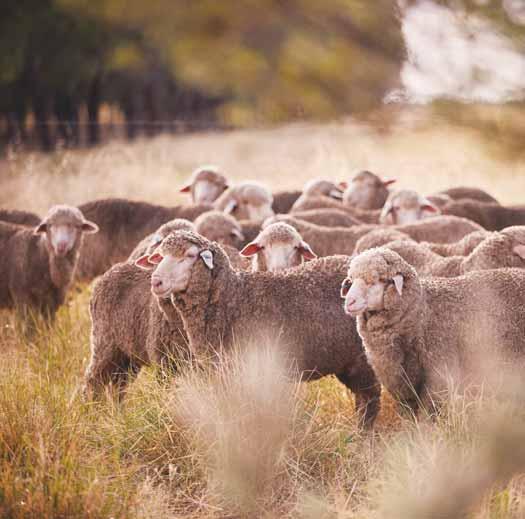
The Woolmark Company represents and promotes the use of Australian Wool.
able and recyclable, making it a perfect fiber for a sustainable eco system.
Beyond luxury fashion, where Woolmark reports wool emerged as a key fiber in recent Spring/Summer collections, wool’s natural properties and seasonal adaptability are motivating sports brands to launch innovative wool apparel.
“As citizens demand more from what they wear — comfort, performance, traceability and responsibility — merino wool is meeting the moment,” said Woolmark Managing Director John Roberts. “With leading influencers and brands alike embracing its story, it’s no surprise demand is rising across luxury fashion, sportswear and lifestyle. It’s the fiber that truly delivers, naturally.”
Innovations from Nuyarn®, Woolx, Ciele, PAKA and Allbirds are proving that natural fibers can deliver technical performance without compromise.
By Rachael S. Davis, Executive Editor
Following is a snapshot of some companies and apparel/footwear brands that are championing the use of wool fiber.
IIn the current era of sustainable textiles, one natural fiber has been quietly staging a come back.
According to The Woolmark Company — a not-for-profit subsidiary of Australian Wool representing the global Australian wool supply chain and promoting the use of wool in premium textile products — merino wool presently is in demand at unprecedented levels.
A recent press release from Woolmark shared that the Australian wool market has experienced its largest price increase in 30 years, in part influenced by “tight inventories, genuine consumer demand and renewed confidence across the supply chain …” Woolmark believes this shift in the market is because of real demand and is not a short-term movement.
According to the press release, the market value for wool is predicted to almost double from $34.9 billion in 2022 to $63.2 billion by 2033.
Once a wardrobe staple along with cotton, wool lost market share with the advent of man-made fibers. Concerns about animal welfare also painted wool as a less than desirable fiber choice. But the natural advantages of wool — including warmth, durability, elasticity, odor resistance, temperature regulation, moisture management, resilience and breathability, among other properties — make it too valuable to exclude from the fiber choice landscape. As a 100percent natural performance fiber, wool also is biodegradable, renew-
According to Andy Wynne, CEO of New Zealand-based Nuyarn®, “The wool industry has undergone a remarkable transformation.” Wynne sees wool escaping its traditional categories of suits, formalwear and sweaters, among other categories, and becoming a “legitimate performance and comfort material across diverse categories including everyday hoodies, footwear uppers, women’s activewear, technical sportswear, loungewear, athleisure, and beyond.”
Technology advancements, such as Nuyarn spinning technology, are helping drive the shift in tradition. Nuyarn’s twist-free spinning technology drafts superfine merino wool with a high-performance nylon filament carrier yarn to produce an ultrafine, two-ply yarn with more volume and aeration than merino yarns made using traditional worsted spun-yarn technologies (See “Nuyarn: Wool A New Way,” T W , January/February 2023). According to the company, the
light weight and softness of the resulting yarns make them perfect candidates for next-to-skin applications in baselayer garments in particular.
Rather than avoiding the conversation, Wynne prefers to tackle historical concerns about wool head on. The company uses transparency, certification and education including full Responsible Wool Standard (RWS) certification, which ensures rigorous animal welfare standards and traceability from farm to finished product. “We’re also bluesign ® , GOTS, and OEKO-TEX certified, demonstrating our commitment across the entire production chain,” Wynne shared.
Nuyarn’s primary customers are active outdoor and lifestyle brands seeking to integrate natural fiber performance garments into their product lines. “Our development process is highly collaborative and tailored to each brand’s specific needs and customer base,” Wynne said. “As a fully vertical business — controlling everything from yarn production to fabric manufacturing to finished garments, we can offer brands a streamlined partnership with a single entity rather than managing multiple suppliers.”
Just some of the apparel brands using Nuyarn include:

• Artilect — A long-time proponent of Nuyarn, Artilect offers baselayer products and accessories made using the yarn including the Flatiron 185 crew and leggings, which are made using a baselayer yarn blend — 91-percent superfine Nuyarn merino wool and 9-percent nylon — knit into a 185 gram per square meter (gsm) fabric that is bluesign certified. Artilect uses hangtags to share the benefits of Nuyarn with consumers under the “More than merino” tagline. The brand also incorporates a TAP wifi-enabled sticker on the hangtags so users can scan using a smartphone to learn more online.
• Ibex — Ibex features Nuyarn in its Woolies Pro Tech Q-Zip and Woolies Pro Tech Bottom baselayers. The fabric, comprised of 85-percent merino wool and 15percent nylon, weighs 125 gsm making it Ibex’s lightest weight base layer ever. While Ibex does not promote Nuyarn specifically on the hangtags, it touts the benefits of merino in a thoughtfully designed hangtag. The company does explain Nuyarn and all of its benefits on its website in the product descriptions.
• Lé Bent — Committed to performance, apparel brand Lé Bent features Nuyarn in its Featherweight Hooded Merino Crew top and Featherweight bottoms. The 125 gsm fabric is made using a Signature Merino Blend that contains 60-percent merino, 25-percent bamboo and 15-percent nylon.
Nuyarn also has established partnerships with Allbirds and HOKA, and the footwear industry currently makes up one of the company’s largest categories.
Additionally, Wynne announced that the Herculan ® technology has allowed the company to transition carpet wool — coarse fibers historically relegated to flooring and upholstery applications only — into high-performance wearable garments. “We’ll be launching a performance wool fleece using this material in fall 2026,” he shared.

“Wool isn’t a fiber of the past, it’s a fiber of the future and I wouldn’t be in this business if I didn’t believe that,” Wynne said. “We’re at an inflection point where consumers are actively seeking alternatives to synthetic materials due to growing awareness of microplastic pollution and climate concerns. Athletes and outdoor enthusiasts are driving demand for natural, sustainable performance options, and technology like Nuyarn makes those choices viable without performance compromise.”
Woolx was founded in 2012 in Endicott, N.Y. as family-run brand focused on merino wool clothing that combines technical performance and everyday comfort. The product line incorporates essentials, pajamas, shapewear and layers, in ultra-heavyweight fabrics, featherlight pieces and everything in between for all seasons.
Traditional wool has an average thickness of 30 microns, while typical merino wool — known for its fineness — has an average thickness of 21 microns. To avoid any itchy, scratchy sensations against the skin,
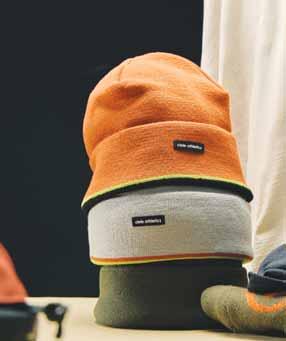
Woolx uses a super-fine merino wool with an average thickness of only 17 microns in many of its products.
“While wool might make some people think of their grandma’s scratchy sweater, this is not that,” said Nicole Calleo, co-founder and CEO, Woolx. “We’ve taken all the natural benefits of traditional wool — temperature regulation, durability and comfort — and reimagined them in a modern, insanely soft merino that’s as stylish as it is functional.” In addition, all of Woolx’s clothing is ethically sourced and responsibly made. “Every Woolx piece is certified non-mulesed ensuring the highest standards of animal welfare and sustainability, ” Calleo said.
Woolx offers the Stella Leggings and Piper Pocket Leggings. Stella represents one of Woolx’s warmest baselayers for fall and winter, while Piper is a merino wool baselayer with functional side pockets for all-day comfort and performance.
“The idea for Woolx’s merino wool baselayer leggings came from a simple need: clothing that could keep up with active, outdoor lifestyles without compromising comfort,” Calleo said. “The founders wanted something that could move easily, breathe well, and regulate temperature during hikes, runs or even when used in everyday
wear. Merino wool turned out to be the perfect solution — warm when it’s cold, cool when it’s warm, and soft enough to wear all day.”
The company recently extended the use of merino wool to mini Woolx, a new line of kids’ baselayers.
Based in Montreal, Ciele Athletics — focused on headwear and apparel for runners — was founded in 2014 by Jeremy Bresnen and Mike Giles. “We are all very passionate about running, technical garments, responsibility, and doing the best we can as individuals and an organization,” said Dan Marrett, global marketing director, Ciele Athletics.
Ciele works with suppliers to develop technical fabrics and perfor-

“We’ve been exploring natural performance fibers for a while and that exploration led to our Sorino™ fabric line,” reported Ciele’s design team. “Partnering with an industry leader like Woolmark felt like the right move to help us highlight everything that makes merino exceptional. The Woolmark certification gives runners confidence that they’re getting the best quality merino possible. It’s a mark of fiber integrity, performance and traceability — all things that align with how we approach design and manufacturing at Ciele.”
Ciele is reimagining merino as a year-round performance fabric, not just a cold weather choice. “For us, reimagining merino means leaning into what it already does best and redesigning around its strengths to create true, all-season performance,” the company shared.
While sheep’s wool currently is experiencing unprecedented demand, Peru-based PAKA is firmly focused on another fiber in the protein family — alpaca. Founded in 2017 by Kris Cody, the certified B-Corp. business works directly with non-governmental organizations alongside the indigenous people in Peru to create its natural, all-purpose clothing and accessories (See “PAKA: Tri-Blend Fiber Trio,” TW , November/ December 2022) . PAKA’s mission remains one of connecting people to where their clothing comes from and supporting the communities who make the garments.
mance constructions tailored for running and movement. The brand recently partnered with Woolmark to launch its first-ever Woolmark-certified merino wool collection of apparel and headwear for winter. According to Ciele, each piece is independently tested and meets the Woolmark standards for durability, colorfastness and quality. Pieces in the line include beanies, balaclavas and baselayers made using 100-percent wool as well as merino/silk blended yarns.
“At PAKA, we’re continuously exploring how natural performance can evolve across categories,” said Megan Krajco, PAKA Design director. “Our foundation began with alpaca fiber in sweaters, but our vision is to build a complete ecosystem of products that support everyday explorers.”
Most recently, Paka has expanded into the outerwear category with its patented PAKAFILL® alpaca insulation material, which can replace down
or synthetic fiber fill options, providing needed warmth without weight. PAKAFILL is featured in the brand’s Apu parkas and Mayu vests and jackets for men and women.
One interesting product that resulted after a 2022 PAKAFILL puffer launch, was a packing cube. In contrast to the company’s alpaca focused products, the upcycled packing cubes are made using deadstock polyester shell fabric left over from puffer production. The company was determined not to send the unusable material to landfill and came up with the idea for the packing cubes. “From day one when Kris originally founded PAKA, our focus has been to help consumers connect to our natural world, make more conscious choices and support the Peruvian communities where our products come from,” said Laura Rysz, senior director of Brand and Marketing, PAKA. “That mission truly remains at the core of everything we do today, from the decisions we make on product development to starting team meetings with PAKA Foundation updates.” The foundation was formed in early 2025 to support “alpacas, alpaqueros, weavers and education for the Peruvian communities we work with,” Rysz shared.
PAKA just announced its firstever Heritage Collection, co-created directly with master Quechuan artisans in Peru. The company gives back 5 percent from sales of the collection to the artisans’ non-governmental organization.
PAKA has also branched out into underwear and continues to innovate in knitwear building on “The Hoodie,” the original sweater PAKA developed. In addition, “the alpaca fiber in every PAKA item now is traceable back to the source,” noted Krajco.
“The wool/protein fiber market has made an incredible shift toward transparency, traceability and regenerative land management that was not part of the mainstream conversation 10 years ago,” Krajco offered. “At the same time, technology is
A champion of wool since its founding in 2015, footwear brand Allbirds, San Francisco, recently introduced its first fully waterproof collection in three silhouettes — the Wool Runner NZ Waterproof, Wool Runner NZ Mid Waterproof and the Wool Cruiser Waterproof. Each shoe upper is made using merino wool and is treated with C-Zero per- and polyfluoroalkyl substances (PFAS)-free durable water repellent (DWR). An additional breathable, waterproof membrane placed between the upper and interior lining further prevents water from penetrating the upper and reaching the feet.
not yet developed a fully waterproof, all-weather option for showers, heavy rain or slushy conditions.

“We were really excited about C-Zero DWR because it gave us the all-weather performance we needed, without having to use PFAS,” said Adrian Nyman, chief design officer, Allbirds. “In the design and development process, we explored different PFAS-free DWRs an ultimately selected C-zero because it delivered the perfect balance of water-repellency, durability, and played well with our toolkit of natural materials.”
Allbirds previously offered a weather-resistant Mizzle style, but had
allowing us to enhance what nature already perfected — through improved spinning, dyeing, and knitting techniques that preserve fiber integrity and reduce the environmental impact. What excites us the most is the fusion of tradition and innovation. We’re using modern tools to amplify the story nature already tells through fiber.”
As wool and other protein fibers step back into the spotlight, the apparel industry is seeing a convergence of innovation, transparency
“We wanted to redefine what waterproof shoes could be, with an Allbirds twist,” Nyman, said. “While most waterproof shoes lean utilitarian and technical, we believe that by looking to natural materials like wool, we can bring something new and exciting to this space.”
When Allbirds got its start, wool was not material ordinarily used in footwear applications. “But our founders knew it had incredible properties that could be put to use,” Nyman said. In 2016, when Allbirds introduced its first shoe, the Wool Runner, the product “flew in the face of all the ‘usual rules’ of footwear, particularly because of the use of merino wool, an untapped natural material in an industry so often dominated by virgin synthetics,” Nyman noted. “Almost 10 years later, Allbirds has sold nearly a pair of Wool Runners every minute, and the style has become a mainstay in wardrobes around the world — safe to say the founders were onto something!”
and consumer demand. Whether it’s Nuyarn pushing the boundaries of yarn engineering, Woolx refining next-to-skin comfort, Ciele reimagining merino for performance, Allbirds redefining footwear rules, or PAKA building a modern ecosystem around alpaca, these companies illustrate how nature and technology can thrive together. In a landscape once dominated by synthetics, wool and its protein-fiber counterparts are reshaping the future of performance, comfort and sustainability. TW
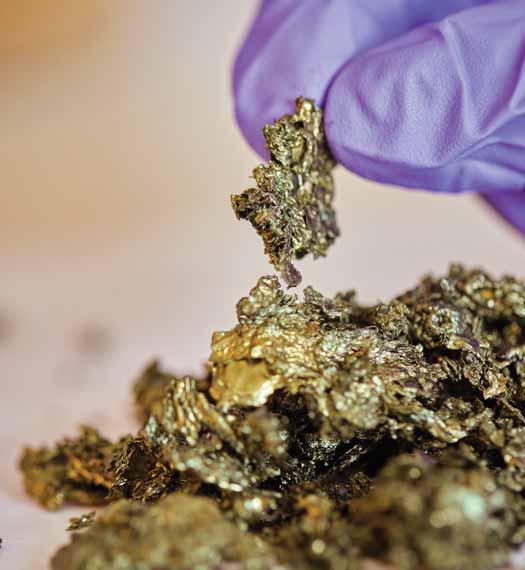
Plastic that’s moldable, biocompatible, glitters like gold and can conduct an electric charge can be used for everything from sensors that detect and even treat serious illnesses to selfcooling clothing or electronic adhesive bandages.
Images courtesy of Chalmers University of Technology|Henrik Sandsjö
Using plastic capable of conducting electric charge paves the way for the body to go online.
Special Report
It’s moldable, biocompatible and glitters like gold. Plastic that can conduct an electric charge is a material that can be used for everything from sensors that can monitor one’s health to self-cooling clothing or electronic adhesive bandages that can be applied to the skin and send data directly to a mobile phone. Researchers at Chalmers University of Technology in Sweden recently presented a groundbreaking “recipe” that makes it easier to manufacture this kind of sought-after electrically conductive plastic in larger quantities — without the use of harmful chemicals, and in a much more cost-effective way.
“Once higher production volumes are achieved, it is possible to work
with the material in a completely different way. Larger quantities are needed to enable the development of a range of applications, for example in biotechnology, energy storage, and wearable electronics,” said Christian Müller, professor at the Department of Chemistry and Chemical Engineering at Chalmers and co-author of a study recently published in Science Advances. 1
In the lab in the Chemistry building at Chalmers, doctoral student Joost Kimpel shows how this glittering, gold-colored material can be easily molded with his gloved fingers. Currently, the market price for just 100 grams of this type of conductive plastic would be around $100,000 — about 10 times as much as actual
gold. But for the human body, it is in fact the absence of metals that makes this material so valuable.
“While some metals can corrode in humid environments, conductive plastic is an organic material that our bodies are comfortable with. The material is compatible with the body’s own tissue, while also being a semiconductor. There’s also an environmental advantage in that you don’t need to use the rare earth elements required for today’s electronics,” Kimpel said. He is first author of the new study.
There is great interest in conductive plastics, or conjugated polymers — the scientific term for them — and the applications are many, not least in biotechnology. According to the researchers, these applications could include sensors that monitor medical conditions, provide information about fitness and health, or adjust the delivery of drugs for diseases that are difficult to treat. With this kind of technology, the body can be connected to other wearable electronics, and even to mobile phones.
Conductive plastics also can be used for various kinds of implants or be 3D-printed to create electronic adhesive bandages that can detect an infection, for example.
Research into conductive plastics is being carried out in many parts of the world. Müller’s research group has been exploring this type of material for more than a decade and has made several important advances in the field.
The key to the new manufacturing method was discovered quite serendipitously during a routine experiment in the lab. When a chemical reaction was happening too fast and the resulting plastic was reaching its final state too quickly, the idea was devised to reduce the heat in the process. This was what led to the discovery that you can produce this
One important ingredient for plastics that can conduct electricity are conjugated polymers. Conjugated polymers are a type of semiconductor and have properties that make it possible to produce a new type of technology — organic electronics — that can be used in many different applications such as energy conversion and storage, wearable electronics, electronic textiles, and biotechnology attached to or worn close to the body.
Unlike inorganic materials such as metals, conjugated polymers can be made flexible and soft. They can be applied to surfaces and used to manufacture solar cells, and are compatible with liquids such as sweat and blood, which is important for bioelectronic applications. Research to
make conjugated polymers stable and improve their conductive properties has been conducted for decades.
It was discovered in the 1970s that certain types of polymers can conduct electricity — a discovery that led to Alan J. Heeger, Alan G. MacDiarmid and Hideki Shirakawa receiving the Nobel Prize in Chemistry in 2000.
The basic ingredients originate from the aromatic compounds thienothiophene and bithiophene, which are the basic building blocks of many organic semiconductors. These substances are mixed in the benign solvent N-butyl-2-pyrrolidone in the
material at room temperature — involving significantly fewer steps, with lower energy consumption, and without toxic chemicals.
“The ingredients in our ‘recipe’ are benign and can be used safely in an industrial setting, unlike the highly toxic substances that must be used to produce many conjugated polymers today,” Kimpel said. “Avoiding toxic chemicals in the production process means a safer work environment for staff, gives the consumer peace of mind, and facilitates recycling. In addition, the costs can be radically reduced, as toxic substances require advanced handling, especially in terms of protective procedures, storage and the disposal of residues.”
Even though the study was published very recently, researchers have already noted a great deal of interest,

When the basic ingredients are mixed with the benign solvent in the presence of a palladium catalyst, the solution changes color almost immediately.
presence of a palladium catalyst.
Almost immediately, the transparent solution begins to change color as the building blocks start to assemble into polymer chains. These larger and longer molecules form the basis of the conductive plastic.
Once the color has changed from yellow to deep red and then to deep purple, the reaction is complete.
not least from the many researchers at other universities who have contacted them. Now they hope that this new production method will facilitate making conductive plastics more widely available.
“An important discovery made in this study is that the production method makes the conductive plastic much better at conducting an electric charge, which also means that the electronics that use this kind of material can be made more powerful,” Müller noted.
The next step in this research will be to continue working on a method that makes it possible to produce even larger volumes — continuously and with exactly the same results every time.
“The possibilities are great, but it’s ultimately up to society and the market to decide what will be developed. It’s a big step from the lab to industrial-scale production, but we hope
The mixture is then washed using several different solvents to remove impurities. Finally, the solvents are removed using rotary evaporation — a method similar to distillation.
After the separation process, a glittering goldcolored substance remains, the color being an indication that the material is electrically conductive. The production of the conductive plastic is now complete.
that this new production method will be of benefit,” Müller concluded. TW
References: 1 https://www.science.org/doi/10.1126/sciadv.adv8168
Editor’s Note: The research article “Open-flask, ambient temperature direct arylation synthesis of mixed ionic-electronic conductors” was published in Science Advances. The authors are Joost Kimpel, Youngseok Kim, Hannes Schomaker, Diego R. Hinojosa, Jesika Asatryan, Jaime Martín, Renee Kroon, Michael Sommer and Christian Müller. These researchers are active at Chalmers University of Technology, Linköping University and AutoSyn AB in Sweden, Technische Universität Chemnitz in Germany, and Universidade da Coruña in Spain. The research is funded by the EU’s Horizon 2020 program, the European Research Council (ERC), and the Knut and Alice Wallenberg Foundation.
Spain-based lining fabric producer Textil A.Ortiz recently commissioned a fourth Monforts Montex tenter from Germany-based A.Monforts Textilmaschinen GmbH & Co.KG. The nine-chamber Montex 8500-9F installation at Textil A.Ortiz’s Santa Perpètua de Mogoda facility features direct gas heating,a Hercules needle chain,Matex finishing padder and two heat exchangers.The equipment is used to finish fabrics with softeners,water repellents and flame retardants.
Altoteks,a specialist in dyeing and finishing fabrics for workwear and uniforms,has installed its third Monforts Thermex continuous dyeing range at its Çorlu,Turkey facility.The company already operates two Ther-
mex units and a Montex finishing range as part of its annual 18 millionmeter dyeing and printing operation. The new two-meter-wide line includes three linked Thermex units, gas-powered infrared predryers,and cold pad batch winding.It also features the Econtrol® process for reactive dyes,designed to support faster, simplified continuous dyeing.
Printeez Inc.,a Quebec-based custom apparel provider,has expanded its digital production capabilities by increasing its Kornit Atlas MAX POLY systems from two to four units.The company serves brands,creators,franchises,nonprofits and sports teams across North America,focusing on polyester and
Bluestar Alliance,New York City, has completed its acquisition of the Dickies brand from VF Corp.The deal brings the heritage workwear label into Bluestar’s expanding portfolio — which includes Off-White,Palm Angels,Scotch & Soda and Hurley — and represents more than $13 billion in global sales.Dickies will operate within Bluestar’s youth-luxury division and continue growing its presence across global streetwear and workwear markets.“Dickies is one of the most authentic,resilient brands in global apparel,”said Joey Gabbay, CEO of Bluestar Alliance.The company plans to expand Dickies through new categories,partnerships,and international distribution while maintaining its longstanding identity.
Avery Dennison,Mentor,Ohio, has extended its partnership with the San Francisco 49ers,continuing as the team’s exclusive partner for personalization and embellishment technologies via its Embelex solutions portfolio. The updated agreement expands in-venue customization at the 49ers Team Store at Levi’s® Stadium with new stations for personalized jerseys and customizable Levi’s jackets.“This partnership shows how far fan engagement has come,”said Steve Mason, vice president,general manager,Commercial & Embelex,Avery Dennison. “It used to be about buying a jersey off the rack.Now,with on-demand customization and digital patches,fans can create something personal and interactive; a memento that connects
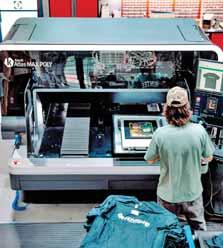
Printeez recently installed two more Kornit Atlas MAXPOLY systems.
blended garments.By shifting production volumes from screen printing to digital,Printeez reports reduced labor needs,fewer manual steps and faster turnaround times.
“Printeez was born out of a passion to disrupt and transform the future of the apparel industry,”said Shawn Sckoropad,founder and CEO at Printeez.“Our mission is to build a true retail-grade print-on-demand solution for individuals and major brands alike.” TW
them to a moment,a season,even the community around the team.”
Circulose has partnered with Marks & Spencer (M&S).The collaboration supports Circulose’s goal of expanding circular materials in the fashion industry,with M&S planning to integrate a significant volume of CIRCULOSE® — a material made entirely from textile waste — into future collections.CIRCULOSE enables brands to reduce reliance on virgin fibers while lowering waste and emissions.“We are thrilled to welcome M&S as Circulose’s first Scaling Partner in the UK,”said Jonatan Janmark,CEO of Circulose. “Their leadership in sustainability and commitment to circular fashion plays an important role in accelerating adoption of next-generation fibers.” TW
With its robotic apparel manufacturing platform and microadhesive technology, startup company CreateMe is pioneering a new approach to apparel production that could help bring manufacturing back to U.S. shores.
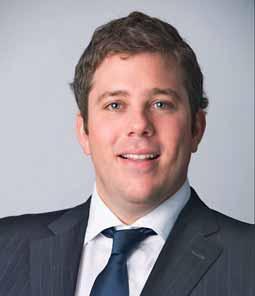
IIt’s a widely accepted fact at this juncture that reshoring cut-and-sew operations in the United States is going to require some use of automation and robotics in order to overcome a trained labor force shortage,among other issues.
Founded in 2019, Newark,Calif.-based CreateMe is on a mission to combine automation, robotics and advanced adhesive technologies to transform apparel manufacturing.Originally a small innovation lab,the company has grown into a multidisciplinary technology organization that employs a team of engineers, chemists and designers — all operating with a start-up mindset — to bring sustainable garment production closer to the consumer.
CreateMe recently announced the launch of its robotic apparel manufacturing platform as well as the first commercial grade products made using the technology — women’s intimates.The Modularengineering Robotic Assembly (MeRA™)
paired with a proprietary microadhesive technology named Pixel™ provides “a scalable,high-precision platform that replaces traditional sewing for longevity,shortens production timelines,and enables sustainable,on-demand manufacturing in the U.S.,”according to the company.
CreateMe notes that the apparel industry generates 92 million tons of textile waste and loses more than $180 billion to inefficiencies tied to speculative production.“CreateMe enables a new business model for the industry — responsive, localized,on-demand manufacturing that replaces forecast-driven production with datadriven precision,”said Cam Myers,CreateMe’s founder and CEO.“Our value lies in transforming how apparel is made and how manufacturing works, making it faster,cleaner, and closer to demand.”
Textile World recently had the chance to speak with CreateMe’s Myers to learn more about this
apparel manufacturing platform — with more than 200 prototypes,more than 1,000 process tests and almost 100 issued patents — and its potential to bring manufacturing closer to the consumer.
TW : What led to the development of MeRA and the Pixel microadhesive technology?
Myers: The development of MeRA and Pixel grew directly from CreateMe’s mission to redefine how apparel is made.
Traditional sewing and offshore production had reached their limits — too slow,too labor-intensive, and too resource-heavy to support the future of on-demand,sustainable manufacturing.Rather than improving legacy processes,our team chose to rebuild them entirely. By uniting robotics, computer vision,and adhesive science,our engineers and materials scientists developed MeRA,a modular robotic assembly platform,and Pixel,a precision microad-
hesive technology that bonds fabrics without thread.Designed in tandem,they form a single integrated system that enables faster,cleaner,and more flexible production, laying the foundation for truly scalable,on-demand apparel manufacturing.
TW : Automation in soft goods is notoriously difficult,especially when handling soft,drapey fabrics.How does the CreateMe technology handle those issues?
Myers: Soft-goods automation has long been constrained by the nature of fabric; it stretches, drapes,and shifts unpredictably,making precision control extremely difficult. CreateMe tackles this from the ground up through advanced materialhandling and assembly algorithms.Our systems use specialized end-of-arm tools and vacuum fixtures to maintain fabric tension and alignment,effectively transforming a deformable textile into a stable,robotreadable surface.

The MeRA platform is designed to assemble as much of each garment as possible in 2D,where accuracy and throughput are highest,before transitioning into controlled 3D operations for forming or joining.Traditional sewing is especially hard to automate because it demands two-sided access,continuous feeding and dynamic thread control.Our Pixel microadhesive bonding process removes those constraints,enabling static,single-sided assembly with precise edge alignment and integration into 3D molds or shaping tools.
Building on this foundation,CreateMe’s Physical AI software extends our machine-learning and computer-vision algorithms into a unified control layer that adapts in real time to different fabrics and garment types.It’s what allows our systems to achieve finedexterity manipulation and industrial-grade repeatability across one of manufacturing’s most variable and complex materials.
TW : Can you talk about how the adhesives work and if there are any limitations compared to sewing?
Myers: Unlike traditional sewing,which mechanically stitches fabric together with thread, CreateMe’s process uses precision robotics and Pixel microadhesive technology to bond materials at the fiber level.This approach eliminates puncture holes, reduces bulk,and creates seamless,flexible joins that enhance comfort, durability and design freedom.The adhesives are engineered to be lightweight,washable, and compatible with a broad range of fabrics,and in some cases thermoreversible,allowing garments to be reheated and separated for recycling.
Integrated within CreateMe’s MeRA robotic platform,the process is faster,more consistent,and easily automated,enabling scalable,on-demand production that minimizes waste and inventory risk. While certain niche applications or highly
thermoreversible,allowing bonds to be safely released under controlled heat so fabrics can be separated and recycled by material type. This capability creates a pathway toward circular manufacturing—where garments can be disassembled,reclaimed,and reintroduced into production rather than discarded.
TW : Is the technology proprietary and only to be used in CreateMe facilities,or is it something you foresee licensing to other producers?
textured materials may still favor traditional stitching, CreateMe’s bonded construction meets or exceeds sewn performance across strength,comfort and sustainability metrics.
TW : How durable and sustainable are the bonded garments? What’s the potential for recycling?
Myers: CreateMe’s bonded garments are engineered for both durability and sustainability.The Pixel microadhesive forms strong,flexible bonds that often exceed sewn seams in tensile strength and wash performance,maintaining integrity through repeated wear and laundering.
On the sustainability side,the process eliminates thread,minimizes material damage from needle punctures,and supports on-demand,localized production — reducing excess inventory,transport and waste.A major advantage of CreateMe’s adhesive platform is its recyclability potential: certain formulations,known as Thermo(re)set™,are
Myers: Our technology is proprietary by design, forming the foundation for both our own manufacturing operations and select licensing partnerships.Within apparel,we’re already engaging with partners on a license-tooperate model while continuing to scale production within CreateMe-operated facilities.Longer term,the versatility of our underlying platform also opens opportunities in adjacent industries that rely on the assembly of technical textiles,such as automotive, aerospace,home goods and medical,where we expect to extend licensing as well.
TW : What’s the potential for reshoring and nearshoring in the United States?
Myers: The potential for reshoring and nearshoring in the United States is both significant and accelerating.Over the past decade,fragile global sourcing models have buckled under freight disruptions,tariffs,and geopolitical shocks,costing
retailers tens of billions and exposing the limits of offshore dependency.What once promised cost efficiency now drives overproduction, poor demand matching and mounting risk.
Over the next five years, we expect a more balanced, matrixed supply chain to emerge.Today,more than 95 percent of apparel manufacturing remains offshore; that mix should evolve toward roughly 70 percent offshore, 15 to 20 percent nearshore, and 10 to 15 percent onshore.The goal isn’t full reshoring; it’s diversification and resilience.By producing closer to demand, brands can reduce lead times,cut waste,and respond dynamically to market shifts.
Technology is the unlock.Digital tools are reshaping design,planning, and product intake to align production with real-time demand,while robotics and Physical AI will enable automated,cost-competitive manufacturing closer to the point of sale.This convergence will give rise to a new generation of responsive supply networks that are faster,leaner and more transparent.
TW : Do you think there are things the government could do to further incentivize companies to reshore operations?
Myers: Absolutely. Reshoring depends on creating the right economic and innovation conditions for apparel manufacturing to thrive locally.That means aligning tax incentives, procurement policy,and workforce development to
make domestic production both viable and competitive, and the current administration deserves real credit for bringing greater focus to this effort.
In recent years,we’ve seen a policy shift toward rebuilding American manufacturing through legislation such as the CHIPS and Science Act (2022) and,most recently, the One Big Beautiful Bill Act (2025),which provides immediate expensing for qualified manufacturing investments,including machinery,automation and other production equipment.For companies
rebuilding and facility investment.If enacted, it would directly support the kind of infrastructure renewal,workforce development and technological advancement required to make U.S.apparel production globally competitive and environmentally sustainable.
Government procurement is another powerful lever.The U.S.remains one of the world’s largest purchasers of apparel — uniforms,workwear and protective gear among them — but smaller, technology-driven manufacturers often face barriers
TW : Why do you do what you do? What motivates you?
Myers: We’re motivated by the ingenuity and grit of the people determined to transform this industry — the engineers,scientists,designers and entrepreneurs who refuse to accept “business as usual.”Every day,we’re inspired by forwardthinking partners who are building new models and proving that apparel can be made better,smarter, and closer to home.
At the same time,we’re driven by the industry’s inertia.Despite years of
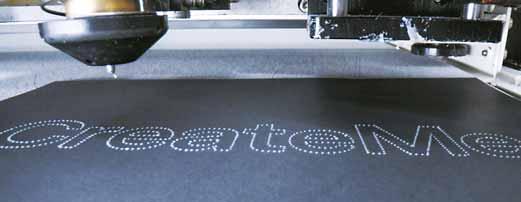
like CreateMe,these measures accelerate ROI on new manufacturing lines, bonded-assembly systems and AI-enabled production technologies,directly improving the economics of onshore production.
The proposed FABRIC Act could be even more transformative for apparel and textiles.It represents the first comprehensive, bipartisan effort to reestablish a competitive U.S.apparel base,pairing strong worker protections with meaningful incentives for domestic production,supply-chain
to participation.Streamlining qualification and contracting processes,or piloting procurement programs that prioritize innovative and automated facilities,would open this channel to next-generation domestic producers.
Finally,workforce development must advance in parallel. Programs modeled on those in semiconductor and advanced-manufacturing sectors,focused on digital design,robotics and systems integration, would ensure reshoring creates future-ready jobs.
conversation around sustainability and innovation, real change has been slow. The technology to make apparel more responsibly already exists; it takes conviction to move beyond entrenched, volume-driven systems.
At CreateMe,we’re turning that conviction into action.Our work is about proving that a different future for apparel isn’t theoretical — it’s within reach, and we’re building it. TW
Editor’s Note:Please see a full-length version of this article at TextileWorld .com
Youngone’s Rae Eun Sung spoke with Textile World about her role in the family business and the company’s role in the global apparel industry.
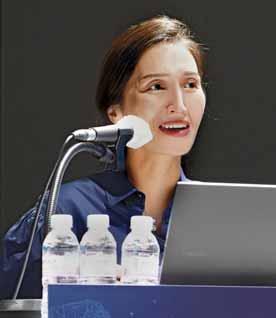
TThe Youngone Group was founded in South Korea in 1974 by Kihak Sung.The company began life as a producer of down-filled winter jackets and ski suits for customers in Europe.Since its founding,the company has become one of the world’s largest manufacturers of premium outdoor clothing, sportswear,shoes,bags, accessories and materials for many of the world’s leading performance brands.Youngone also produces its own brands for the outdoor industry serving consumers across the globe.In addition,Youngone operates the license business for The North Face brand in South Korea,so it not only manufactures but sells directly to consumers through its extensive retail network across Korea.
Today,the Youngone Group is comprised of Youngone Holdings and Youngone Corp.,and both companies are listed on the Korean Stock Exchange.
Textile World recently had the pleasure of speak-
ing with Youngone Group’s Vice Chairman and President,Rae Eun Sung.As the daughter ofYoungone’s chairman and founder, during her childhood Ms.Sung spent time accompanying her father on business trips,shadowing him and visiting the company’s factories during school holidays.“I was fascinated to visit various factories around the world,” Sung said.“I was always destined to be involved with the family business!
TW : What does your current job entail and how do you approach the role?
Sung: I began working full-time for the company after I finished my undergraduate studies at Stanford University in 2002.My father insisted I learn about all aspects of the business, so I’ve worked in virtually every part of the company over the last 22 years.
My father is still actively involved,and he is passionateabout the factory designs, investing in state-of-the-art
machinery and the production processes.His vision for our Korean Export Processing Zone (KEPZ) facility in Bangladesh is to create an entire ecosystem, complete with factories, lush green spaces,schools, a technical institute,a medical complex,a botanical garden and eventually a sports arena,to serve not just Youngone employees and their families,but the wider community.
So I tend to focus on the day-to-day operations of the business,as well as the longer term strategic direction.For example,I set up a $65 million corporate venture capital fund in 2022 in Singapore to nurture startups and innovators, especially in the areas of sustainability and circularity. We are now in the process of setting up the second fund to further expand our investment portfolio.
TW : What is the company’s mission and has the mission changed over time?
Sung: From an early stage I felt it was important to clearly define our company’s vision and mission. So,I developed our vision and mission statements: “Striving for Excellence with Passion.”The company is relentless in its pursuit of excellence and customer satisfaction.Our mission is to be “A trusted and reliable partner,a caring employer and a responsible corporate citizen,focused on sustainability.”
It is now a group of companies with over 90,000 employees with a presence in 17 markets and annual revenues in excess of $3 billion.
TW: Are there any landmark moments in the company’s history?
Sung: There are several highlights worth noting. Becoming the first foreign investor in Bangladesh’s garment industry in 1980 was a key moment.We were also the first company to employ a predominantly female workforce,which challenged cultural norms
at the time.Today,Youngone is the largest foreign investor in Bangladesh and the largest private employer with over 65,000 employees.Another important milestone was our acquisition and long term development of the KEPZ in Chittagong, Bangladesh.
We acquired a barren area of 2,492 acres and over a period of eleven years,we have transformed the area into a lush industrial zone by planting over 3 million trees,creating 37 water bodies to harvest more than 600 million gallons of rainwater each year,and cultivating botanical gardens.As a result,the area illustrates the rich bio-diversity that can be achieved by balancing development and one’s commitment to the planet. I am proud to share our export zone is home to over 137 species of birds and wildlife along with 500 species of plants.
In Korea,one of the most significant milestones was when we set up a joint venture company with our partner Goldwin to launch The North Face products domestically.
TW: Can you share a little about the company’s strengths and current capabilities?
Sung: In terms of our overall key strengths and capabilities,I’d say first and foremost we have unrivaled experience,having started more than 50 years ago.In that time,we’ve worked incredibly hard to build a
reputation for quality, reliability and innovation, which is why we work with so many of the world’s leading brands.Second, our diversification strategy not only enables us to be closer to our customers, it also gives us greater flexibility and resilience. Finally,our vertical integration strategy is a key competitive advantage as it balances our dependence on suppliers,while giving us greater control over quality and improving consistency.
I believe that establishing a clear corporate culture from the outset has been vital to our success. I created the company’s ‘Core Values’over a decade ago and we recently conducted a refresh to ensure all of our global colleagues understand and live the Core Values.
Our Core Values are encapsulated in the mnemonic HEART:
• Honesty and Integrity — We are true and sincere and
adhere to high ethical principles;
• Excellence — We take pride in our work and strive for the highest levels of customer and employee satisfaction;
• Agility — We navigate changing market conditions quickly;
• Responsibility — We value,promote and contribute to communities and society at large and conduct business in a responsible and sustainable manner; and
• Together — We must all live the core values and be accountable for our actions - Together we can make a real difference.
TW : What advantages does a vertically integrated supply chain provide in terms of speed,quality and innovation?
Sung: We embarked on our vertical integration strategy even before the pandemic.At the height
of the pandemic it became clear that we needed to accelerate the expansion of our materials division in order to avoid supply chain disruptions.However,we also saw an opportunity to develop new business models by producing enough material to supply local factories in Bangladesh, so that they too can avoid having to import long lead time materials.Currently, we sell around 50 percent of our Draw-Textured Yarn, 30 percent of our woven and knitted fabrics,and 40 percent of our Ecoloft insulation to local companies.
Aside from avoiding potential supply chain disruptions,we also have complete control over the quality of our own materials, and we can quickly adjust production volumes depending on demand.
TW : The company has a global footprint with manufacturing facilities in Asia as well as Central America.What advantages does this offer?
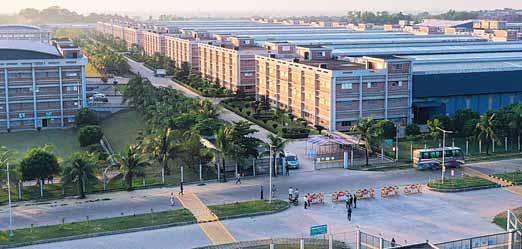
We began diversifying our production facilities more than 20 years ago. In addition to our main production base in Bangladesh,which accounts for around 60 percent of our production,we now have factories in Vietnam,El Salvador, Uzbekistan,Ethiopia and India.This strategy is partly designed to be closer to our customers,which reduces and simplifies logistics.It also provides greater flexibility in case of disruptions for our customers,who seek multi-country,multicategory,vertical operations like ours.
TW : How is a changing apparel retail environment impacting Youngone?
Sung: We firmly believe changing consumer behavior is a good thing.Buying fewer,better quality garments that last longer is definitely better for the environment.However,we
still see continued growth as we acquire new customers and expand into new and developing markets,such as India. We recently opened our first factories in India because it is well known that consumers there favor products made in India.
TW : How does Youngone balance contract manufacturing with developing its own brands and intellectual property?
Sung: We take intellectual property very seriously, which is why we often have specific factories dedicated to our key customers.We also organize our company to create the appropriate firewalls in development and maintain best in class processes to ensure the security of our data and especially our customers’ designs and innovations.
Our retail footprint is in South Korea and focused
on The North Face brand which is customized for this specific market.Over the years we have also made targeted investments in performance companies, always taking great care not to compete with our customers and instead finding the appropriate adjacency,or a totally new category.
TW: How does the company maintain consistency in quality,compliance and innovations across its global manufacturing network?
Sung: In terms of quality and consistency,we have rigorous quality training standards for our quality inspectors across all of our factory operations.The training is updated regularly when we introduce new product lines or processes.
TW : Do you have any thoughts about how AI and automation may affect production,and are there any tools or
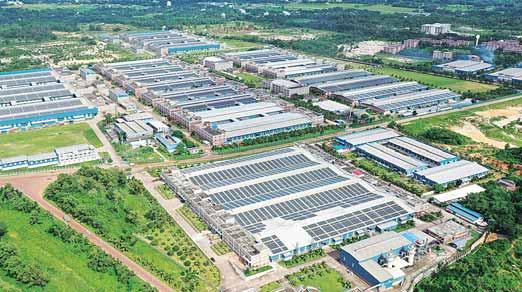
technologies Youngone is looking to adopt?
Sung: We believe AI will definitely have a role to play in the future.We have already started running some trials using AI in areas such as logistics, material planning and utilization.We think there could be significant reductions in material wastage for example.
Working closely with our customers,with their own AI assisted design programs and in combination with our own research and development facilities, we are constantly looking at new materials,tools and technologies.
TW : What are some of the ways Youngone supports workforce development and well-being across its production facilities?
Sung: Youngone has a predominantly female workforce — around 80 percent globally.However, at the KSIGarment factory, women only make up around 20 percent of the supervisors.To address this issue,we have introduced several programs,such as our GEAR program — Gender Equality and Returns — which is designed to train female supervisors.So far,more than 200 women have completed the training in Bangladesh to become supervisors.We have also introduced another program for female supervisors to become managers or technical specialists,

called GEAR Advance.
While this is a relatively new program,more than 30 women have already progressed to become managers and specialists.
TW : Environmental stewardship is an underlying tenet of Youngone.What are the most impactful sustainability initiatives the company has implemented across its global facilities?
Sung: Sustainability and environmental protection has been at the heart of everything Youngone does since the very beginning.Our major initiatives include our solar panel investments.Our goal is to reach 100MWp across our global facilities by 2030. We recently phased out coal-fired boilers in Vietnam and replaced them with biomass boilers. The resulting ash is collected and used to produce fertilizer,which is made available to local farmers.
All of our factories have wastewater treatment plants and effluent processing facilities.We also
have rainwater harvesting facilities at many of our operations.
One of the major initiatives underway is to make of use scraps or recycled material,such as our award-winning “Ecoloft” range of products.More than 40 percent of our synthetic down fillers are made from recycled or scrap materials.
At our KEPZ operations in Bangladesh,we have planted more than 3 million trees and created 37 water bodies that are capable of harvesting more than 600 million gallons of rainwater.
TW : Are there any trends in apparel and outdoor performance Youngone is watching?
Sung: The number one trend is focused around sustainability and circularity. That means products made with a high level of recycled content,which can be further upcycled or recycled.We have been investing in startups and innovators in this space
Sung: We believe the main challenge for Youngone and the garment industry as a whole is sustainability.The combination of regulatory changes in several markets, coupled with growing consumer awareness and shifting buyer practices, means we have to continue innovating and finding more ways to make our business more sustainable.
through our corporate venture capital group.
TW: How is the company positioning itself over the next 5-10 years?
Sung: Our main priority is to continue supporting our new and existing customers with high quality and reliability,especially with so much volatility and the uncertain impact of changing trade landscapes.
In the short to medium term,we will continue to ramp up our sustainability efforts with investments in solar power and recyclable materials.We are continuing to diversify with new factory locations in Africa and Central America. And we are focusing on developing the next generation of designers and innovators with the opening of a Textile Institute in Bangladesh.
TW : If you had to identify one key challenge for Youngone going forward,what would that be and how is the company posi tioned to meet the challenge?
TW : Please give a quick synopsis of the Youngone’s value proposition.Tell readers what sets the company apart and makes it unique.
Sung: There are several key things that differentiate Youngone from other OEM garment makers. Our 50-year history of continued growth and development clearly demonstrate that our fundamental business model is sound and that we are here for the long term. Second,our diverse global operations gives us greater resilience and flexibility, while being closer to our customers.Our“Core Values”ensure all of our 90,000 employees worldwide understand and embody the principles of honesty,integrity,quality and responsibility.And lastly our vertical integration strategy enables us to guarantee consistent quality and reliability. TW
Editor’s Note:Please see a full-length version of this article with additional questions online at TextileWorld .com
bluesign is celebrating 25 years of helping the entire textile and apparel value chain deliver measurable impacts that matters to industry, people and the environment.
TW Special Report


SSwitzerland-based bluesign technologies recently celebrated its 25 anniversary. Established in 2000 to offer sustainable chemical and environmental management solutions for the textile and fashion industry,bluesign developed a science-based input stream management system with the aim of eliminating harmful substances at the source.The system also helps ensure safer working conditions,reduces environmental impacts and provides safer products for consumers.
Today,bluesign counts more than 900 global system partners who work towards benchmarks for responsible production using bluesign’s criteria for chemical use,environmental performance and resource efficiency,while delivering measurable reductions in environmental impact.
“We are the only service provider in the textile sector offering a comprehensive eco-system approach that connects chemical management,manufacturing process optimization,
and sustainable product stewardship,”said Barbara Oswald,chief commercial officer,bluesign.“Our work goes beyond certification and compliance.We deliver measurable improvement solutions and ongoing support to help our partners make sustainability an integral part of their business.”
“bluesign was born out of a bold idea,that sustainability could be embedded into the DNA of product creation,”said Daniel Rüfenacht,CEO of bluesign technologies.“Twenty-five years later,we’re proud to be a beacon of trust,innovation,and responsibility, and to partner with industry leaders worldwide in building a more sustainable future together.”
Textile World recently had the opportunity to speak with Oswald as well as Esther Paez,bluesign’s Sustainability product manager,about the company and what lies ahead having achieved this milestone anniversary.
TW : How has bluesign’s mission evolved since the organization was founded 25 years ago,and what
role do you see bluesign playing in the next decade as new regulations such as the EU Green Deal and Digital Product Passport take shape?
Barbara Oswald: Over the past 25 years, bluesign has evolved from an industry pioneer focused on safer inputs to a trusted partner driving sustainability transformation across the textile value chain.As regulatory expectations increase,our mission remains the same — to help industry produce the lowest possible impact on the environment and people,backed by primary verified data,transparency and practical solutions. Our system is geared for digital traceability and verified information that initiatives like the EU Green Deal and Digital Product Passport will require.In that sense,bluesign enables companies not only to comply,but to lead.
TW : There are other sustainability frameworks including ZDHC,OEKOTEX, and GOTS.How does bluesign position itself among these organizations?
Esther Paez: We welcome the work of other frameworks that contribute to the industry’s sustainability goals.What makes bluesign unique is our integrated,end-to-end approach,geared towards sustainability improvement.We work across the entire value chain,connecting chemical suppliers, manufacturers,and brands through a single verified system.bluesign functions as a service partner,combining data-driven insight, on-site verification and continuous improvement support.
TW : How does bluesign ensure alignment and accountability among a wide range of mills, suppliers,and brands in the global System Partner network?
Paez: Alignment comes from a shared framework built on trust,transparency, and measurable performance.All bluesign System Partners are part of the same ecosystem,connected through common principles,verifiable criteria and a commitment to continuous improvement.
Each partner’s performance is verified on-site and supported through data analysis.But our approach goes beyond verification: Our experts work closely with partners to interpret results,identify improvement areas and implement solutions.This continuous engagement fosters accountability, builds capability,and strengthens collaboration across the entire network.
TW : What are some of the greatest challenges you see today in managing impact,and how does bluesign help manufacturers and brands address them?
Oswald: Today’s biggest challenge is navigating the complexity of multiple sustainability expectations — balancing impact reduction,costs, due diligence,reporting or compliance across many dimensions (ESG).Many companies struggle to connect these dots across their supply chain and geographies.bluesign helps by providing verified primary data,technical insight,and tailored improvement pathways that make sustainable transformation manageable.Through our collaborative model,we help partners move from reactive compliance to proactive impact reduction.
TW : How does bluesign measure and verify environmental improvements at partner facilities?
Paez: Our partner assessments go beyond certification to our stan-
dards,they are designed to drive measurable improvement.We measure resource efficiency,chemical performance,and emissions to air and water.
Following each assessment,we share results and tailored improvement plans with partners,supporting them in setting clear targets and taking practical action.The verified data that results from this process provides a transparent and credible foundation for measuring progress and demonstrating real impact.
TW : How does bluesign maintain credibility in a world where greenwashing and self-reported data are common?
Oswald: Credibility comes from verification and science,not promises. bluesign enables its partners and brands to provide evidence-based sustain-
ability data,helping them communicate honestly and avoid greenwashing.Our ongoing assessments and action plans are based on data review,technical validation and independent on-site evaluation.This gives both brands and consumers’confidence that bluesign stands for proven, trustworthy performance.
TW : Are there any new innovations in processing or monitoring that excite you as potential breakthroughs in cleaner textile production?
Paez: Innovation today is happening where chemistry,process efficiency and circularity meet.We’re particularly encouraged by advances in cleaner dyeing technologies,chemical recycling of polyester,and closed-loop systems that reduce waste and extend material life.bluesign’s solutions are flexible to
accommodate these welcomed new developments — working with chemical suppliers,manufacturers, and recyclers to ensure that new processes meet our safety and sustainability requirements from the start.These innovations show that true sustainability is not about compromise — it’s about smarter chemistry,efficient production and a system that keeps resources in use.
TW : Certification can be complex and expensive, especially for smaller companies or those in developing regions.How does bluesign work with companies to make its services accessible?
Paez: We recognize that every partner has different starting points and capabilities.bluesign offers scalable implementation pathways,allowing each company to progress step-
Over the years, bluesign has expanded the textile and apparel categories covered by its system to include denim, footwear and leather products.
by-step while receiving hands-on guidance from our experts.Our role is to support,not to police.By offering practical tools, regional engagement,and capacity building,we help companies of all sizes participate in responsible production.
TW : Tell readers about the bluesign Academy.
Oswald: The bluesign Academy has long been recognized as our knowledge hub for sharing expertise and training across the industry.As we continue to evolve,this work is becoming more closely integrated within bluesign itself,reflecting how deeply knowledge and expertise are embedded in everything we do. Going forward,we may call it something different,but its purpose remains the same — to equip our partners and the broader industry with the understanding,tools and insights needed to drive measurable improvement and
responsible production.At its core,it’s still about the people and the expertise behind bluesign — helping our partners turn knowledge into lasting progress.
TW : Looking ahead, do you see a future where “clean production”is the default and not the exception? What will it take to tip the scales closer to a safer,cleaner textile production environment?
Oswald: That is exactly the future we are building toward.The shift will depend on these things:
•Collaboration — a shared responsibility across the entire value chain;
•Verification — so progress can be measured and trusted;
•Continuous improvement — supported by knowledge,data and partnership;
•Innovation and scalability — to ensure solutions can grow and deliver impact at every level of the industry; and
•Consumer awareness — empowering people to understand,trust,and choose responsibly produced textiles. When these elements come together,responsible production becomes not an aspiration,but the industry standard.
TW : How is bluesign thinking about the role of consumers in driving sustainability?
Oswald: Looking forward,we are focused on building awareness with end consumers. Ultimately,the demand for sustainable products comes from those who buy them.By evolving our certifications,communication, and transparency,we aim to make it easier for consumers to understand, trust,and choose responsibly produced textiles.
TW : Please give a quick synopsis of your company’s value proposition.What should readers expect from bluesign in the future?
Oswald: bluesign is the only service provider in the textile industry offering a comprehensive eco-system approach,from chemicals to end products,built around delivering improvement solutions and ongoing support.We bring together science,data,and collaboration to help the industry reduce adverse impact and operate responsibly.What truly sets us apart is the long-term trust and collaboration we’ve built with our System Partners over more than two decades.These relationships allow us to continuously refine our system and deliver solutions that are both practical and proven. Looking ahead,we’ll continue expanding our system’s digital capabilities and supporting our partners through data-driven insights,collaboration,and innovation,always focused on measurable,real-world results.
TW : Why do you do what you do? What motivates you?
Oswald: Our motivation comes from the belief that sustainability should be achievable for everyone in the textile industry.We are driven by the progress we see when our partners reduce impact,improve operations,and lead the way toward responsible production.For us,it’s about partnership and empowerment,helping the entire value chain deliver measurable impact that matters to industry,people and the environment. TW
Compliance with FTC regulations is essential to avoid enforcement actions, litigation and penalties.
By Julia Solomon Ensor
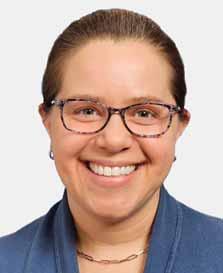
FFor companies in the textile or wool product business, time invested in a compliance check today could save time, money, and hassle associated with a regulatory inquiry in the future. After all, the last time the Federal Trade Commission (FTC) publicly investigated companies for allegedly mislabeling textile products, those companies ended up having to pay millions of dollars in penalties.
When it comes to textile and wool labels, the FTC is the primary federal regulator. Pursuant to the Textile Fiber Products Identification Act, 15 U.S.C. § 70 et seq. (Textile Act), and implementing rules, 16 C.F.R. Part 303,1 and the Wool Products Labeling Act, 15 U.S.C. § 68 et seq. (Wool Act), and implementing rules, 16 C.F.R. Part 300,2 the FTC requires every covered product’s label to include three key pieces of information:
1.fiber content;
2.country of origin; and
3.manufacturer identity.
Labels can contain additional, nonrequired information if it is not misleading, but if a marketer’s label does not address these three categories of information, it is noncompliant.
Historically, most of the FTC’s textile-related litigation has focused on fiber disclosures, with most cases alleging companies misled consumers by using the wrong generic
fiber names. For example, the FTC has repeatedly sued companies selling textiles made from rayon or viscose derived from bamboo pulp for labeling their products as “bamboo” when the labels should have said rayon or viscose.
Most recently, in 2022, the FTC blanketed the marketplace with notices to retailers reminding them that Commission decisions have determined it is an unfair or deceptive act or practice to misidentify a product’s fiber content. The notices included a synopsis of FTC cases reaching this conclu-
Litigation triggered by specific issues with fiber content identification evolved into large-scale matters involving other marketing claims. The FTC ultimately settled the cases for penalties of $2.5 million and $3 million, respectively.
sion. When the targeted retailers failed to clean up allegedly deceptive claims within a reasonable amount of time of receiving the letters, the FTC initiated enforcement actions. And, once the FTC initiated the cases on fiber content disclosures, the threshold alleged Textile Act violations opened the door for the FTC to investigate other marketing
claims on the retailer sites, ultimately arguing that these retailers further violated the law because they also misled consumers as to the environmental benefits of their bamboo-derived products. So, in those cases, litigation triggered by specific issues with fiber content identification evolved into large-scale matters involving other marketing claims. The FTC ultimately settled the cases for penalties of $2.5 million and $3 million, respectively.
With this frame in mind, textile marketers should always begin compliance reviews with a careful check of fiber content disclosures. First, marketers should determine each constituent fiber in each product that accounts for 5 percent or more of the product by weight. For those fibers, companies should ensure they are using correct generic names listed in either 16 C.F.R. § 303.73 or ISO Standard 2076: 2010(E). Marketers should list the names on the label in descending order of predominance. For fibers other than wool that comprise less than 5 percent of the product by weight, companies can generally disclose them as “other fiber[s].”
There are a few allowances in the regulations that make disclosures easier. First, the FTC permits a 3 percent tolerance on claims to account for slight variability across product lines.
So, as long as companies are doing their best to be accurate, error within that 3 percent range is generally low risk. Second, there is no requirement to disclose fiber content for things like collars and cuffs, trim, linings — unless used for warmth — small amounts of ornamentation, or threads that hold a product together. And, finally, if a product includes using clippings or textile waste materials of indeterminant fiber content, it is generally low risk to disclose those materials as unknown fiber content.
Country of origin is next on the compliance checklist. The Textile Act and Wool Act require companies to disclose origin for all products, whether they are imported or made in the United States. For imported products, this is easy. The tag should simply reflect the product’s country of origin as disclosed at time of importation. If the product is not imported, things get a little more complicated. Specifically, when it comes to figuring out whether a textile or wool product that underwent final processing in the United States can be labeled as “Made in USA” or “Made in USA of Imported Materials,” the FTC uses the “one step removed” rule.
The “one step removed” rule requires companies to look at the origin of the materials one step removed from the product’s final manufacturing process. If those materials are imported, the marketer must disclose that on the label. If those materials are U.S. materials, the marketer can label the product as “Made in USA.”
For example, a company selling a woven shirt should look at where the fabric was made, because that step is one step removed from the final step in shirt production — cut-and-sew. If that step happened in the United States, the marketer could label the shirt as “Made in the USA.” But, if the company imported fabric and then cut and sewed it into a shirt in the United
States, the marketer would have to label the shirt as “Made in USA of Imported Fabric.” And, if the product the marketer sells happens to be a flat product like a sheet or a towel, just saying “imported fabric” is insufficient. For those products, companies must identify the county the product came from such as “Made in USA of fabric made in China,” for example.
sourced, evidence of compliance with the “one step removed” standard will be insufficient.
The final item on the label compliance checklist is the identity of the manufacturer, importer, or other dealer. Marketers must include this information because, when people
The ”one step removed” rule requires companies to look at the origin of the materials one step removed from the product’s final manufacturing process. If those materials are imported, the marketer must disclose that on the label.
The FTC has pursued enforcement action against textile manufacturers for incorrect country-of-origin claims on labels. However, those cases have mostly involved egregious conduct. For example, in 2022, the FTC sued a marketer for allegedly ripping tags out of apparel products that appropriately disclosed the products were made in China and replacing them with “Made in USA” claims. That company and its owner settled with the FTC for an injunction and monetary relief of $211,335.
Although the “one step removed” analysis is the rule for most textile manufacturers seeking to label their products as “Made in USA” for sale to consumers, it is important to note that there is an additional wrinkle for marketers selling their products to the Department of Defense (DoD). Specifically, companies supplying products to the DoD should be aware that the Berry Amendment, 10 U.S.C. § 4862, and its implementing regulations in most cases prohibit the DoD from acquiring clothing or textile products unless those products are domestically sourced. In general, a covered product will not comply with this requirement unless its entire production process — from raw material sourcing through final assembly — is performed in the United States. In this context, if earlystage inputs to a product are foreign-
buy a product, they need to be able to figure out who markets, distributes, or otherwise handles it. To comply, marketers can either print company names directly on labels, or, if saving space and facilitating recordkeeping are priorities, apply for and include an optional Registered Identification (RN)4 number on the tag.
Compliance begins with ensuring all labels include these three disclosures, every time. Beyond that, to avoid a regulatory action, marketers should ensure labels are securely attached until products are delivered to customers — in the neck, if the products have one. And, as is true in all advertising, marketers should be careful not to include extra information that could confuse or mislead people. TW
References:
1https://www.ecfr.gov/current/title-16/chapter-I/ subchapter-C/part-303
2https://www.ecfr.gov/current/title-16/chapter-I/ subchapter-C/part-300
3https://www.ecfr.gov/current/title-16/chapter-I/ subchapter-C/part-303/section-303.7
4https://rn.ftc.gov/rns
Editor’s Note: Julia Solomon Ensor is counsel in the Entertainment & Media Industry Group at the Washington-based office of Reed Smith where she helps clients navigate complex advertising and consumer protection challenges. She has 15 years of hands-on experience at the FTC where she served as the Made in USA and Green Guides program manager.

Rieter’s Autoconer X6 offers intelligent data analysis and improved ergonomics as well as flexible automation in package winding.
TW Special Report
Rieter’s new Cop Exchanger enables more flexible automation.
The Cop Exchanger offers userfriendly operation and high flexibility. It has a large empty tube capacity and can process two lots — with identical tube lengths — in parallel. Its boxes are easy to change. The unique decentralized material flow enables flexible combination with the spinning tube stripper and the Color Check, ensuring correct tube assignment via tube color monitoring.
The machine’s length has been reduced by 350 millimeters (mm) to 818 mm, improving space efficiency — even in 96-spindle machines. This is especially beneficial for integration into existing buildings. The compact design is based on sections with six or 10 winding units and a newly designed, space-saving energy unit.
SSwitzerland-based Rieter Ltd.’s winding machine Autoconer X6
Type V delivers on every front, according to the company. Equipping it with the Cop Exchanger, which automatically removes defective cops, means yarn quality is safeguarded, production seamless and operator workload reduced. The all-new compact design combines ergonomic comfort with enhanced safety features. Additionally, the Ring-Winder-Connect module enables targeted operator guidance to faulty spindles. It improves quality, reduces waste, lowers energy use, and enables preventive maintenance.
Customers with a high degree of automation rely on the Autoconer X6 type V with its direct connection to the ring spinning machine. The integration of Cop Exchanger and Ring-Winder-Connect increases
process reliability and performance, while simplifying operation and data analysis.
The Cop Exchanger works based on the results of the spindle identification system SPID. This detects alarm cops with faulty yarn, as well as off-standard cops with below-average yarn quality. Additionally, sensors in the automation aggregates monitor processing status of the cops and detect those that cannot be processed, for example. Smarttrays and RFID technology enable an intelligent cop material flow. Based on collected data, the Cop Exchanger removes affected cops from the Smarttrays and replaces them with empty tubes. Cops are sorted into two boxes: one for cops that cannot be processed, one for lower yarn quality cops.
Rieter engineers also have optimized the machine’s ergonomics. The operating height at the winding unit is now 80 mm lower, thus increasing the operator’s safety and comfort. In addition, the new color scheme aligns the Autoconer X6 with Rieter ring and compact-spinning systems.
The new Autoconer X6, Type V, is ready for advanced data analysis and management with the Ring-WinderConnect module. It analyzes SPID quality data from the Autoconer X6 and data from individual spindle monitoring system ISM on the ring spinning machine. This enables targeted operator guidance to faulty spindles. Ring-Winder-Connect improves quality, reduces waste, lowers energy use, and enables preventive maintenance, according to the company. TW
The Jones Family of Companies, Humboldt, Tenn., has hired Eric Delaby as senior director of sales.
New York City-based nonprofit Accelerating Circularity has announced founder and current CEO Karla Magruder will transition to board chair, where she will continue to guide the organization’s strategic direction. As part of the transition, Eileen Mockus was named new CEO.
Jonathan Puckett was appointed CFO of Houstonbased specialty chemicals company Orion S.A.
New Zealandbased Nuyarn® has named Monica Ebert vice president, sales, North America.

Suominen Corp., Helsinki, has appointed Francois Guetat COO and a member of the Suominen Leadership Team.
Fruit of the Loom Inc., Bowling Green, Ky., has appointed Scott Daley senior vice president –Brands. He replaces Tony Iannuzzi who is retiring at the end of the year.
John Brearley was named president, Americas, for Paris-based Lectra
Brett Bjorkman was named CEO of Next Level
Apparel, Torrance, Calif. He replaces the founder Joe Simsoly who has retired.

Julian Sponseller has joined the direct sales team at Emigsville, Pa.-based Herculite Products Inc. as Western Regional Manager. Austin Barshinger was named the new Quality Supervisor at Herculite’s facility in York, Pa.
England-based Think Group recently hired Harriet Adams as development director, and Lance Bray as a key accounts manager.
Compression brand CEP Running, Durham, N.C., has named Marc Sylvester National Specialty sales manager.
The American Apparel & Footwear Association (AAFA), Washington, has promoted its senior vice president of Policy, Nate Herman, to executive vice president.
England-based Carrington Textiles has hired Kim Proctor as sales manager. She will focus on a portfolio of accounts and drive growth across flame-retardant, printed and workwear fabrics.
The Global Nonwovens Alliance (GNA) has announced its inaugural board members. GNA is a federation established by the Association of the Nonwoven Fabrics Industry (INDA), Cary, N.C., and Brussels-based EDANA the Voice of Nonwovens. Murat Dogru was appointed CEO of GNA. INDA representatives on the GNA board are Mark A. Thornton, The Procter & Gamble Co.; Mike Clark, Hollingsworth & Vose; Jodi Russell, The Clorox Co.; Paul Harmon, Magnera; Douglas Dowdell, International Paper; and Jaren J. Edwards, Everra. EDANA’s representatives on the GNA board are Mikael Staal Axelsen, Fibertex Personal Care/Innowo Print; Jörg Ortmeier, TWE Group; Giorgio Mantovani, Corman S.p.A.; Thorsten Habeck, BASF; Ulrich Hornfeck, Sandler AG; and Anke Renz, Essity.
Covation Biomaterials (CovationBio), Newark, Del., has appointed Steven Ackerman CEO.

Chris Blakeslee was named the first independent board member of Unspun, San Francisco.
The Supervisory Board of the Germany-based Karl Mayer Group has appointed Lutz Wolf CEO of Karl Mayer Holding SE & Co. KG
Sophie Boulanger is the new CEO of SRTX, Montreal, the company known for Sheertex® tights.

Microban International, Huntersville, N.C., has appointed Shermon McMillan president.
The American Association of Chemists and Colorists (AATCC), Durham, N.C., awarded its 2025 Olney Medal to Dr. Karen K. Leonas, professor in the Department of Textile and Apparel, Technology and Management at NC State’s Wilson College of Textiles; and the Harold C. Chapin Award to Barry P. Brady, AATCC board member and AATCC Foundation board member.
Avery Dennison Corp., Mentor, Ohio, named Mariana Rodriguez vice president and general manager, Materials Group EMENA.
The Washington-based United States Fashion Industry Association (USFIA) named Michael Lambert executive director of Global Trade and Compliance. TW
Shawmut,West Bridgewater,Mass.,recently launched Shawmut™ Insights,a proprietary Life Cycle Assessment system for its automotive textiles,from raw materials to end-of-life.
Microban International, Huntersville,N.C.,recently introduced EcoFresh™ odor capture technology that was designed with active and outdoor enthusiasts in mind.
1888 Mills,Griffin,Ga., and Cotton Incorporated, Cary,N.C.,have codeveloped a new bath and bedding collection that comprises 100-percent cotton towels,sheet and bedding at an accessible starting price point.

Italy-based Thermore® has introduced Thermore Freedom,a 100-percent recycled thermal insulation material developed for active warmth and its ability to adapt to movement.
Fire-Dex,Medina,Ohio, has launched Fire Investigation PPE,a protective ensemble designed specifically for fire investigators.
Primaloft,Latham,N.Y., has expanded its product portfolio with the addition of six new products including PrimaLoft® UltraPeak™, ThermoPlume® PrimaLoft ReRun™,Silver PrimaLoft ReRun,PrimaLoft ThermaStretch™,PrimaLoft HeatSphere™ and PrimaLoft Rise Sleeping Bag™
Intrinsic Advanced Materials,Gastonia,N.C., reports the Home Fashion Products Association recognized its CiCLO® technology with the 2025 Home Excellence Behind the Seams award.In other CiCLO news,Minneapolis-based BOKSER Textiles has introduced the Vermilion Sheeting Collection — a blend of 52-percent polyester treated with CiCLO® and 48-percent modal.
For the third consecutive year,the Central Penn Business Journal and Lehigh Valley Business have named Herculite, Emigsville,Pa.,as one of the Best Places to Work in Pennsylvania in 2025.
TheTextile Institute, England,is celebrating its 100th anniversary.Its Royal Charter was granted in 1925 by King George V. England-based Nonwovenn reports it achieved its 19th consecutive year of profitable growth,with a 25-percent growth in sales year-over-year during the 2024-25 financial year.
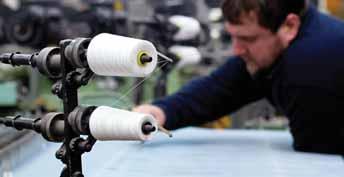
Cincinnati-based Standard Textile and hospitality brand Accor have launched the Mascioni Hotel Collection as the preferred luxury linen provider for some of Accor’s brands including Fairmont,Sofitel Legend,Sofitel and MGallery Collection.
SDL Atlas,Rock Hill,S.C., has released the latest iteration of its Scorch/ Sublimation Tester,which offers improved accuracy,efficiency and operator safety while testing fabrics that are under heat and pressure, according to the company.
England-based Replin by Hainsworth,a producer of fabrics for aviation and transport interiors,is celebrating 80 years since its founding by Hungarian refugee and textile innovator Dr.Maurus Banyai.
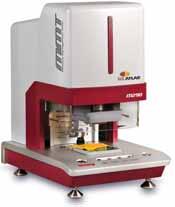
The American Association of Chemists and Colorists (AATCC), Durham,N.C.,reports the OEKO-TEX® Eco Passport certification,Number 21.0.93288,has been renewed for its AATCC Powder Laundry Detergent.
Atlas Material Testing Technology,Mount Prospect,Ill.,recently introduced the nex-gen Ci3000 Weather-Ometer.The unit features almost double the sample capacity,enhanced irradiance and temperature uniformity,as well as a new user interface.
Milliken & Company, Spartanburg,S.C.,reports its Milliken Assure™ Moisture Barrier was awarded a 2025 R&D 100 Award.The flame-resistant moisture barrier designed for firefighter turnout gear is nonhalogenated, non-per- and polyfluoroalkyl substances (non-PFAS) and UL-certified. Assure is certified to both NFPA 1971-2018 and NFPA 1970-2025 standards.
Sunbrella®,Burlington, N.C.,has launched Sunbrella Interiors,a new sub-brand of fabrics and products developed for interior spaces.The product line includes plush chenilles,bouclés and other soft,textured fabrics; window treatments; and throws.In addition, Sunbrella has expanded its Sunbrella Horizon® marine vinyl collection with 14 new stock keeping units including the Tuscano leather-grain texture style in two colorways. TW
April 21-24 :Techtextil & Texprocess 2026, Messe Frankfurt Fairgrounds,Frankfurt, Germany.Visit techtextil.messefrankfurt.com and texprocess.messefrankfurt.com.
April 29-30 :Textiles Recycling Expo USA, Charlotte Convention Center,Charlotte, N.C.Visit events.amiplastics.com/ textiles-recycling-expo-usa.
May 19-22 :INDEX™ 26,organized by EDANA,Palexpo,Geneva.Visit indexnonwovens.com.
June 9-13 :ITM 2026,Tüyap Fair Convention and Congress Center, Istanbul,Türkiye.Visit itmexhibition..com.
June 29-July 2 :WOW — World of Wipes® International Conference, organized by the Association for the Nonwoven Fabrics Industry (INDA), Grant Hyatt Nashville,Nashville,Tenn. Visit worldofwipes.org.
August 4-6 :Techtextil North America, Raleigh Convention Center,Raleigh,N.C. Visit techtextil-north-america.us. messefrankfurt.com.
August 25-26 :RISE® — Research, Innovation,& Science for Engineered Fabrics — 2026 Conference,organized by INDA,McKimmon Center,NC State, Raleigh,N.C.Visit riseconf.net.
September 20-24 :ITMAAsia + CITME 2026, National Exhibition and Convention Center, Shanghai.Visit itmaasia.com/shanghai2026.
October 28-29 :FiltXpo™ 2026,organized by INDA,Minneapolis Convention Center, Minneapolis.Visit filtxpo.com.
November 3-5 :Advanced Textiles Expo 2026,organized by the Advanced Textiles Association (ATA),Orange County Convention Center,Orlando,Fla. Visit advancedtextilesexpo.com.
November 16-19 :Hygienix™ 2026, organized by INDA,Hyatt Regency Houston,Houston.Visit hygienix.org. TW


A 55-piece collection showcases the climate-positive AeoniQ™ cellulosic yarn designed to rival polyester and nylon in performance.
By Rachael S. Davis, Executive Editor
CONTACTS:
For more information, visit pangaia.com.
Go online to TextileWorld.com
in the 55-piece AeoniQ™ capsule collection.

LLondon-based PANGAIA — a company established to scale cuttingedge material solutions — recently introduced a limited-edition 55-piece capsule collection of hooded jackets, half-zip overtops and straight-leg trousers made using AeoniQ™ cellulosic filament yarn developed by HeiQ, Switzerland. An alternative to fossil-fuel derived fibers, AeoniQ was designed to imitate the performance of polyester and nylon while offering closed-loop circularity.
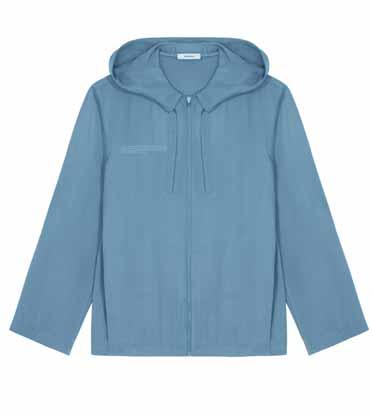
HeiQ and PANGAIA have previously collaborated, and “Over time, our partnership has evolved to explore more transformative technologies that can shift the textile industry toward regenerative, closed-loop systems,” said Chelsea Franklin, head of Advanced Concept Design, PANGAIA. “AeoniQ represents the next chapter of that collaboration, a truly circular, climate positive alternative to synthetics like polyester and nylon.”
Renewable cellulose feedstocks, including wood and eucalyptus pulp, form the starting materials for AeoniQ, making the fiber fully recyclable and biodegradable. When used in place of polyester, the fiber may reduce emissions by up to 3.2 kilograms of carbon dioxide equivalent per kilogram of yarn, according to assessments by Amsterdam-based Fashion for Good and South Pole, Switzerland.
AeoniQ is a continuous filament with a smooth, lustrous surface; and innate tenacity,
abrasion resistance and drape. “The performance properties are inherent in the AeoniQ filament itself,” Franklin shared. “HeiQ’s proprietary spinning technology allows precise control over filament formation, giving the yarn its strength, resilience and smooth hand feel.” Yarn twist and fabric density as well as final fabric weight also can impact durability in the finished garments. Applications include both apparel and technical textiles.
According to Franklin, AeoniQ does not fibrillate so it maintains a smooth and stable finish with no pilling, which makes it different to typical cellulosic fibers. “Additionally, AeoniQ can be texturized, providing diverse hand feels and allowing designers and manufacturers greater flexibility in creating both soft and structured textiles, something not possible with traditional cellulosic fibers,” Franklin shared.
For the capsule collection, PANGAIA worked closely with both HeiQ and Italybased mill Beste to develop the 100-percent AeoniQ fabric. “The capsule was intentionally limited, only 55 pieces, to showcase the material’s potential and validate its performance through design,” Franklin said. “HeiQ is currently scaling AeoniQ production with plans to increase capacity over the next year. As availability increases, PANGAIA is exploring a broader application of AeoniQ across product categories where performance and circularity intersect.
“At PANGAIA Lab, we believe design plays a critical role in bridging scientific innovation and cultural desirability,” Franklin said. “By translating new materials like AeoniQ into timeless wearable pieces, we can help shift perception, showing that responsible innovation can be both advanced and accessible.” TW
website / magazine / e-newsletter
Subscribe to Textile World for complete coverage of the U.S. and global textile manufacturing industry — the latest technologies, applications, regulations and trends.
Now you can receive your Textile World magazine anywhere you go.
Print advertisers receive additional reach and linking with free inclusion in Digital Editions.
read / share / engage
